

GRG News for 2012-2014
There were
to the News Section of our website, as of the Start Date on May 1, 1999;
[For
reference, our Counter had
3,082 hits as of February 20, 2001;
15,202 hits as of June 14, 2002;
40,847 hits as of January 2, 2003;
83,065 hits as of January 1, 2007;
112,538 hits as of June 22, 2007;
139,848 hits as of January 1, 2008;
150,000 hits as of April 11, 2008;
161,000 hits as of August 4, 2008;
187,000 hits as of January 12, 2009;
221,500 hits as of January 5, 2010,
257,827 hits as of January 5, 2011;
322,654 hits as of July 21, 2012;
359,067 hits as of June 16, 2013; and
378,570 hits as of January 17, 2014.
The Hitometer.com website for tracking hits to our website has been out of
business starting January 2000.
To fill this void, on June 16, 2005, we switched over to the webbot Site Meter at
freestats.com.
Click on the icon above for more details. As there were
29,400 hits as of January 3, 2005,
we estimate that we are now receiving ~55,000 hits per year at the current rate].
Actually, there were 53,794 hit for the 12 months ending June 16, 2006
and also 161
members of our World-Wide GRG Discussion Group as of this date.
June 27,
2009; As of this date, there were 222 members.
As of June 16, 2013, there were 489
members.


Our News Section could just as well been called a blog (short for web log), but this now-popular phrase didn't exist until very recently in the last few years. Our blog is a chronological listing of news items with source references for each one interspersed with editorial remarks as we see fit to give us some perspective on where the field of gerontology is moving, even by scientists who would never refer to themselves as gerontologists.
Click for News from earlier years: 1998-1999; 2000; 2001; 2002; 2003; 2004; 2005; 2006; 2007; 2008; 2009; 2010; 2011;

For more information about this announcement, please click here.
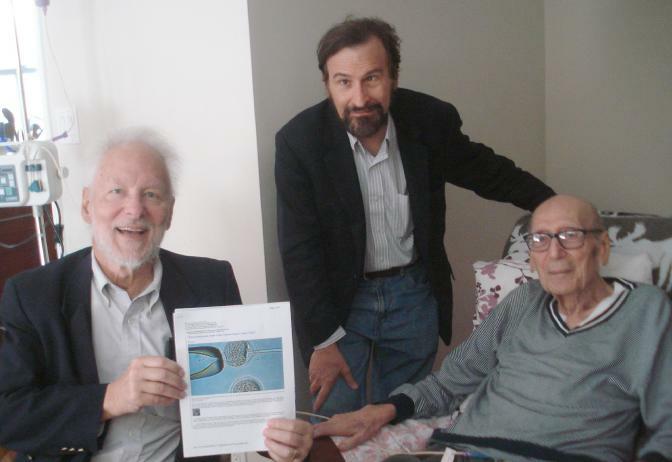
Sunday, April 20, 2014; 2:00 PM; A short one-hour visit to Bob Nathan's home in Pasadena,
CA.
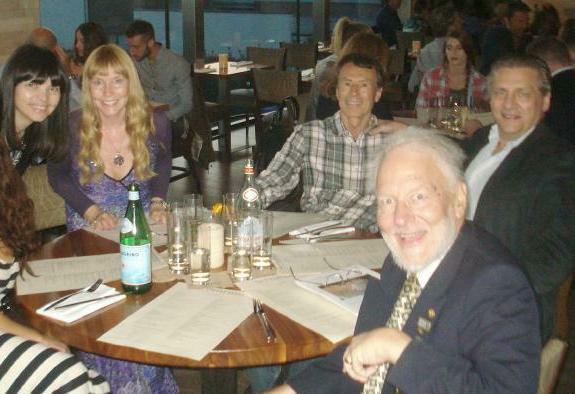
Saturday, April 19, 2014; 7:30 PM; Friends of the GRG at dinner in Manhattan Beach, CA.
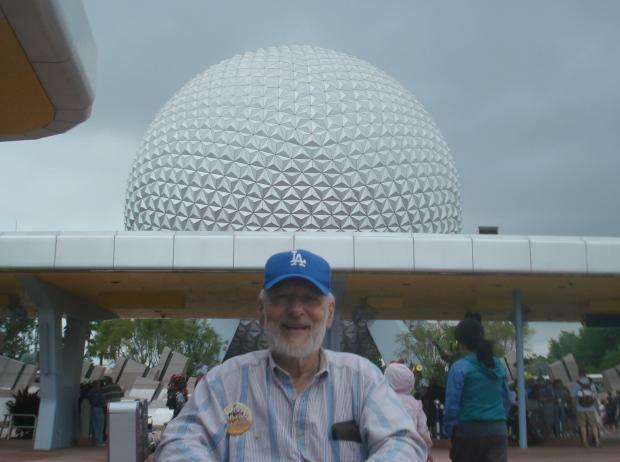
Thursday, April 17, 2014; Noon, EDT; Steve Coles at the Epcot Center (Disney World) in
Orlando, FL.
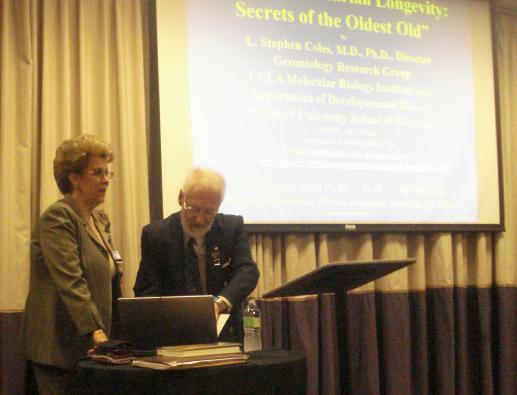
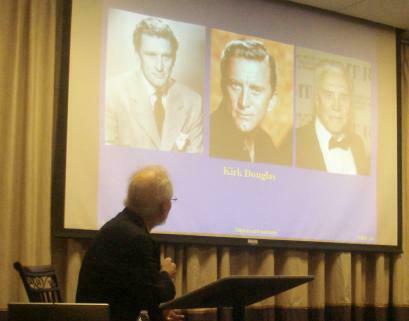

Thursday, April 16, 2014; 10:00 AM (two hours) and 6:30 PM (one hour) EDT; Dr. L. Stephen
Coles gave the April Distinguished Lecture on Aging at the Florida Hospital in Orlando, FL at
the invitation of Dr. Antonio Novello, M.D., former US Surgeon General.
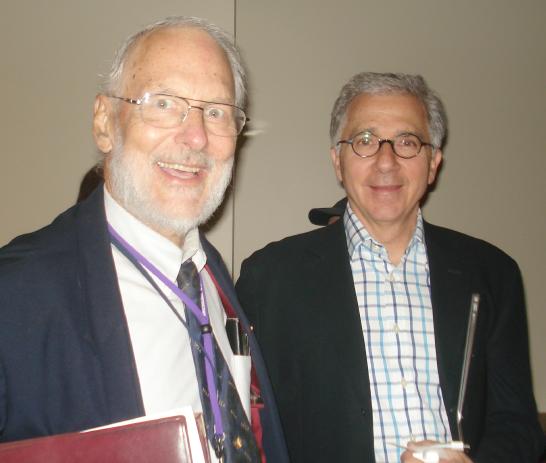
Wednesday, April 9, 2014; Noon; Prof. Douglas Melton, Ph.D., Director, Harvard Stem Cell
Institute, Xander University Professor at Harvard, Member of the National Academy of Sciences
and the Institute of Medicine, spoke on the topic of "Making Pancreatic Beta Cells." He showed
that hiPSC's can make Islet Beta Cells today in his lab at the billion cells espansion after years of
frustrating blind alleys and false-start hypotheses. One original idea that came out of the Q&A
session that may impact the organ transplantation/rejection problem is the use of an HLA protein
known to protect embryos/fetuses from the Mothers' immune system that might be used to make
xenographic organ transplants appear to have the same protection as fetuses by coating foreign
tissue with this type of HLA protein. A curious factoid during the lecture was that if there were
no apoptotic Programmed Cell Death in the tissues containing our replicative cells and they
continued to divide at their normal rates, the volume of our future bodies would be the equivalent
of 70 Earths after one year of incredible exponential expansion. So, thank goodness for cell
turnover and the recycling of old, senescent cells. Of course, we need to examine the
consequences of keeping lots of senescent cells around as they age (that consume oxygen and
nutrients without making a contribution to the tissue function, in those tissues in which they are
embedded, as they may have once done) in older tissues without having them be recycled and
replaced by fresh cells.
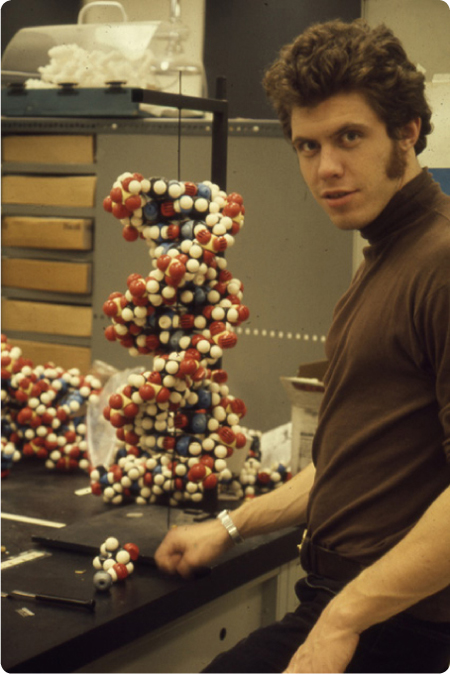

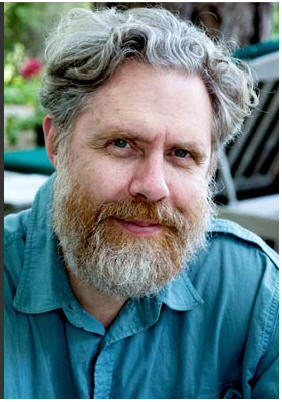
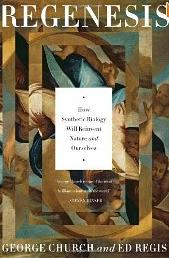
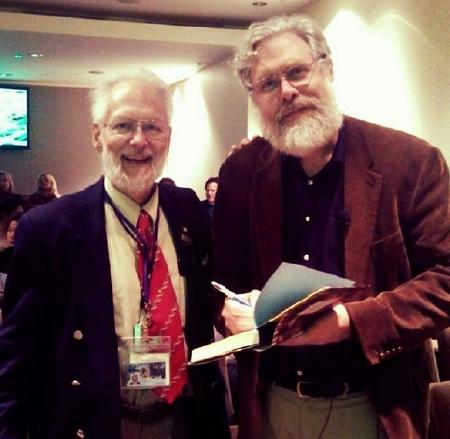
Wednesday, March 26, 2014; [Noon - 1:00 PM] PDT; Geneticist Prof. George Church of
Harvard University spoke to a full auditorium at today's UCLA IMED Noon Seminar on the
topic of "Technologies for Reading and Writing Genomes." In particular, he spoke about
CRISPER/Cas9 technology as well as the new BRAIN Initiative which he helped initiate with his
early Neuron paper, Vol. 74 (November 21, 2012) that led to President Obama's
announcing it in his 2013 "State of the Union Address" as a Grand Challenge." Finally,
he intimated that they were collaborating with a commercial venture from Miami, FL on
the complete sequencing of 30 Supercentenarians, while showing a slide of Madam Jeanne
Calment smoking a cigarette.
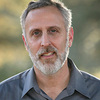
March 20, 2014; [9:30 - 10:15] AM; Telephone interview of Dr. Coles by Mr. Gil Weinreich of
Think Advisor and Editor-in-Chief of Research Magazine.
Other References:
1. CDC Mortality
Tables
2. Life
Expectancy by
Country.
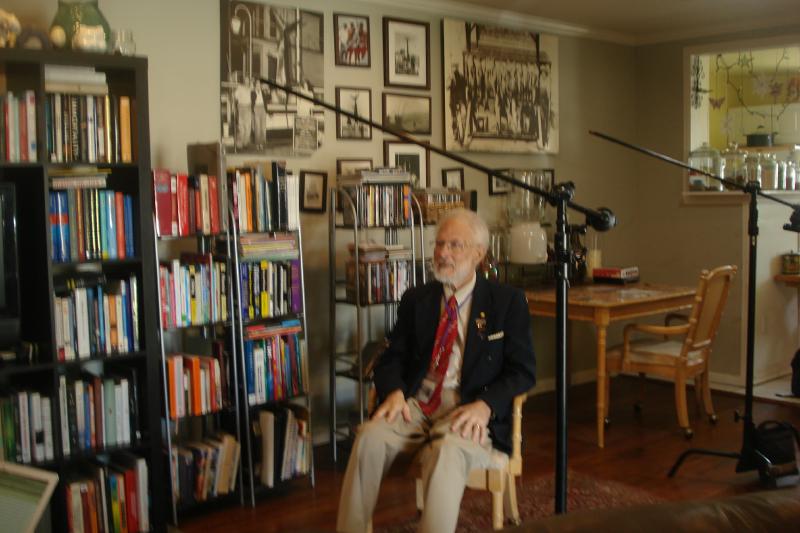
Saturday, March 15, 2014; [2:00 - 5:00] PM PDT; Dr. Stephen Coles was interviewed by
CNN Reporter Alan Duke concerning a Monk who claimed to be 122 yo. This claim is now
being investigated by the GRG (that has a history of skepticism regarding extreme longevity
claims). Our Monk died last year, but not before he was interviewed by two experts who
prepared a lengthy video documentary for the occasion.

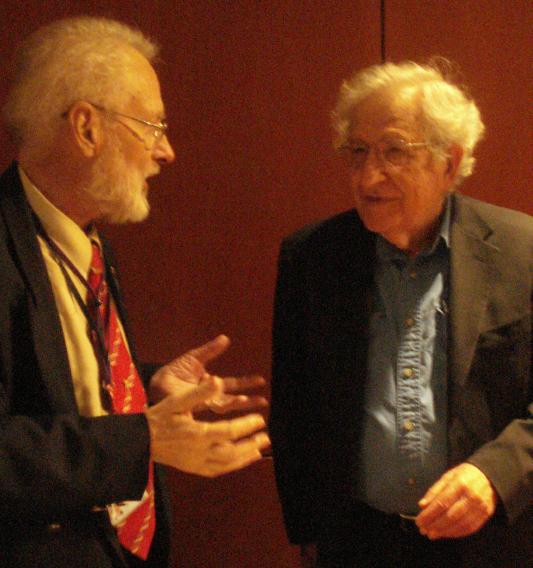
Friday, March 14, 2014; [Noon - 1:00 PM] PDT; Emeritus Prof. Noam Chomsky of MIT
lectured at UCLA about the state of the world. As a computational linguist, he is most noted as
the father of Transformational Grammar which he created back in 1965 but now mostly as a Left-
Wing anti-war protester against both Democratic and Republican Administrations.
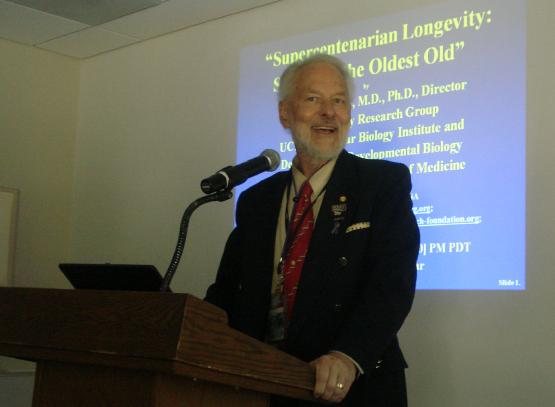

Wednesday, March 12, 2014; [10:00 - 11:15] AM PDT; Prof. Coles lectured to an audience of
~30 members at the Leo Baeck Temple in Los Angeles near the Getty Museum off the 405
Freeway.

Saturday, March 8, 2014; [9:30 AM - 3:00 PM] PST; The Plato Society of Los Angeles held its
Annual Milhaupt Symposium at the Mount St. Mary's Catholic College in Los Angeles, CA. The
Panelists included Dean Pinchas Cohen, M.D. of the USC Leonard Davis School of Gerontology
and Executive Director of the Andrus Gerontology Center, who spoke on the topic of "The Aging
Revolution: Longevity in the 21st-Century."
Dr. Laurie Zoloth, Ph.D., McCormick Professor of Bioethics at Northwestern University in
Chicago, IL who spoke on the topic of "Utopia Is Hard Work: Duty and Freedom for the 120-
Year Old."
Dr. Aubrey de Grey, Ph.D., Biomedical Gerontologist and Chief Science Officer of the SENS
Research Foundation who spoke on the topic of "In a future Free of Age-Related Disease,
Longevity Is a Welcome Side Effect." and
Dr. JoAnn Damron-Rodriguez, Ph.D., Professor of the UCLA Multicampus Program in Geriatric
Medicine and Gerontology who spoke on the topic of "A Critical View of the Societal Aspects of
Extreme Longevity,"
After lunch and Breakout-Room Discussions, Dr. Gary Small, M.D., Professor of Psychiatry and
Aging and Director of the UCLA Longevity Center spoke on the topic of "Strategies for Living
Longer and Better."
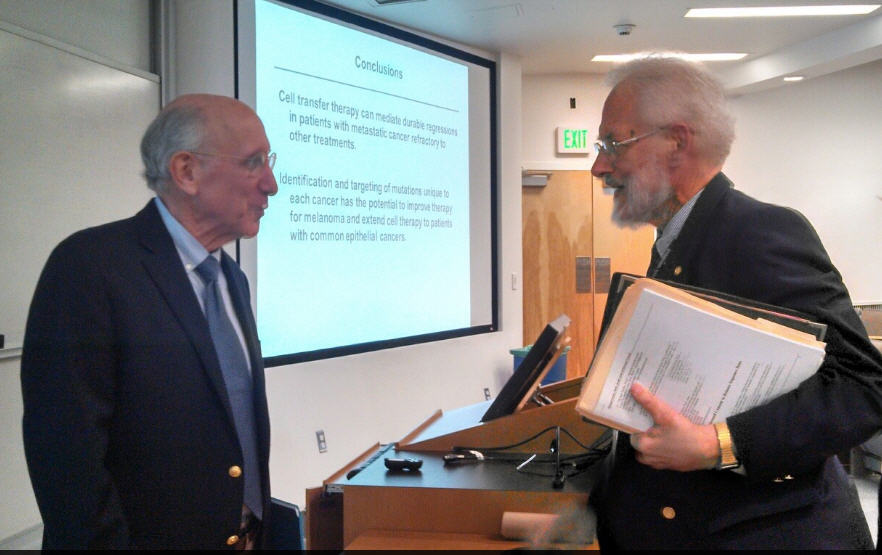
Thursday, March 6, 2014; 12:00 Noon; Dr. Steven A. Rosenberg, M.D., Ph.D., Chief of the
Surgery Branch of the NCI at NIH in Bethesda, MD spoke on the "Curative Potential of T-Cell
Immunotherapy for Cancer" to a packed audience with students sitting on the floor in
CHS 73-105. Tumor sequences are now know to contain an average of 234 mutations. About 25
mutations don't even fit into a pattern, but are unique to each patient. The support for this new
cutting-edge data will appear soon in The Journal of Clinical Investigation.
Photo by N. Coles

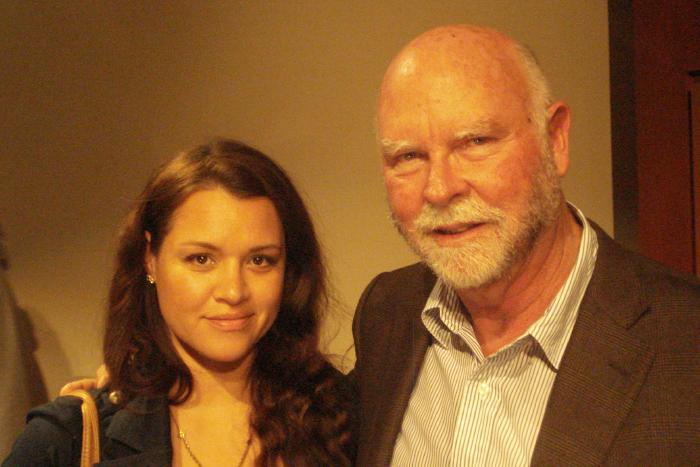
Wednesday, February 26, 2014; 12:30 PM; Dr. J. Criag Venter gave the weekly IMED Seminar
at UCLA on the topic of his book "Life at the Speed of Light." He also mentioned that [30 - 40]
percent of all the essential genes identified in the human genome [those whose knock-outs are
lethal] have an unknown function. He also mentioned that the human biome contains 10,000
unique bacterial genes (in addition to the 20,000 human genes we know about) that are activated
by the food we eat. Many of the protein gene products cross the BBB.
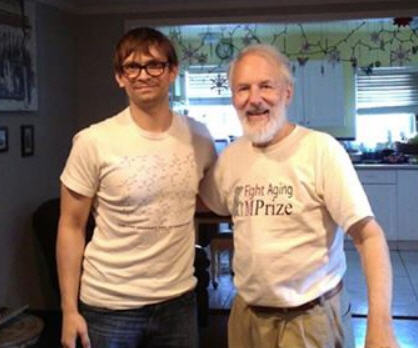
January 15, 2014; 2:30 PM; Dr. Alex Zhavornonkov and Dmitry Kamensky,
a wealthy Russian banker who recently funded a Biology of Aging Laboratory at the
Moscow Institute of Physics and Technology (MIPT) visited Los Angeles on their way from
Hong Kong and then on their way to Johns Hopkins Medical School in Baltimore, MD. They
neglected to update their calendars, having crossed the International Date Line, and got to visit
me at UCLA one day earlier than planned! - - Steve Coles
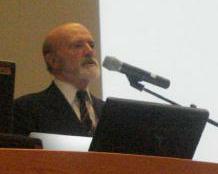
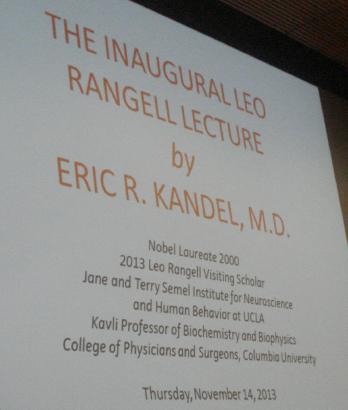
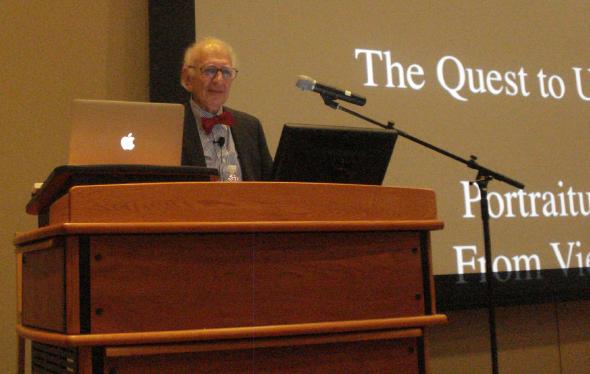
Thursday, November 14, 2013; [4:00 - 6:30] PM; Prof. Peter C. Whybrow, M.D., Director of the
Semel Institute introduced Prof. Eric R. Kandel, M.D., Nobel Prize in Physiology or Medicine in
2000 for his work in memory-encoding in the brain, author of several textbooks, and Kavli
Professor of Biochemistry and Biophysics at Columbia University's College of Physicians and
Surgeons, was the inaugural Leo Rangell Visiting Scholar for 2013 based on an endowment
made possible by Lynda and Stewart Resnick to the Jane and Terry Semel Institute for
Neuroscience and Human Behavior at UCLA to an audience of over 600 persons in the brand
new Palisades Ballroom of Carnesale Commons (Prof. of Physics Albert Carnesale was a former
Chancellor at UCLA). Kandel was born in 1929 in Vienna and came to the US at age 9. His title
was "The Age of Insight: The Quest to Understand the Unconscious in Art, Mind, and Brain
from Vienna 1900 to the Present Day." He surprised the audience with a number of common
optical illusions, the obscure fact that there are six distinctly-separated areas of the monkey brain
involved in face recognition (even cartoons of faces) within temporal/parietal regions and that
these regions are highly interconnected, and finally that so called mirror neurons light up
motor areas in the brain of someone watching someone else carry out motor actions in the real
world, like walking or picking up an object. The level of dopamine rises significantly in the
brain when you are shown a photo of a loved one, but it goes off-the-scale when you are rejected
by your significant other. The lecture was followed by a reception in which Dr. Kandel
graciously answered questions from all parties.

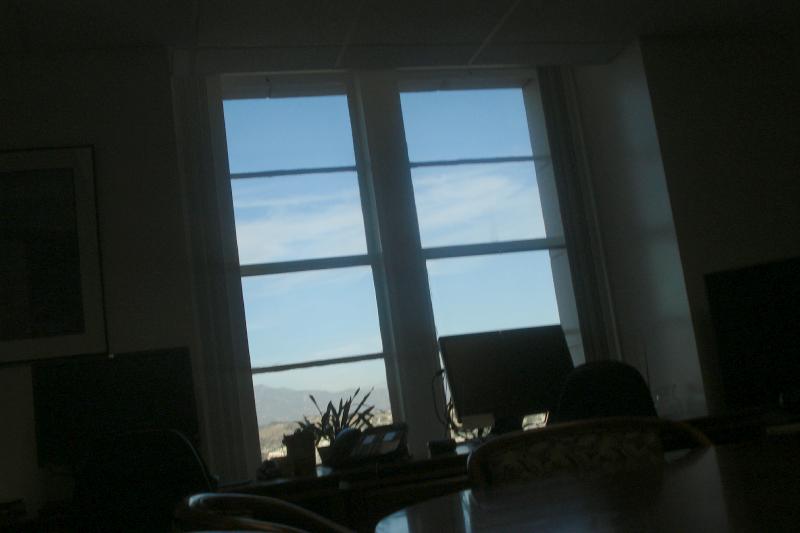
Thursday, November 7, 2013; [10:45 AM - 3:30 PM]; Ms. Rebecca Griffen, Political Director of
Peace Action West of Oakland, CA, Ms. Farideh Kioumehr-Dadsetan, President of the
International Health and Epidemiology Research Center of Sherman Oaks, CA, Dr. L. Stephen
Coles, Director of Physicians for Social Responsibility - LA in Los Angeles, CA, and Rick
Wayman, Director for the Abolition of Nuclear Weapons and the Nuclear Age Peace Foundation
of Santa Barbara, CA met with Mr. Trevor Daley, State Director of US Sen. Dianne Feinstein's
Staff in the morning (Santa Monica Blvd. in West Los Angeles) and Mr. Rafi Nazarians, Senior
Field Representative of US Sen. Barbara Boxer in the afternoon (downtown LA in the top floor
of Federal Court House on North Spring Street) regarding the proposed refurbishment of our
stockpile of ~500 B61 Nuclear Weapons based in Europe (B61 Life Extension Program [B61
LEP]) [US$12 billion] and the W78/88-1 Interoperable Warhead (joint USAF and
Navy)[US$[12-13] Billion] project as well as the issue of conducting diplomacy over
newly-proposed economic sanctions on the government of Iran despite the desire of the new
Iranian President Hassan Rouhani to come to an agreement with the West about their
nuclear-energy program and its potential for building dangerous weapons of mass destruction.
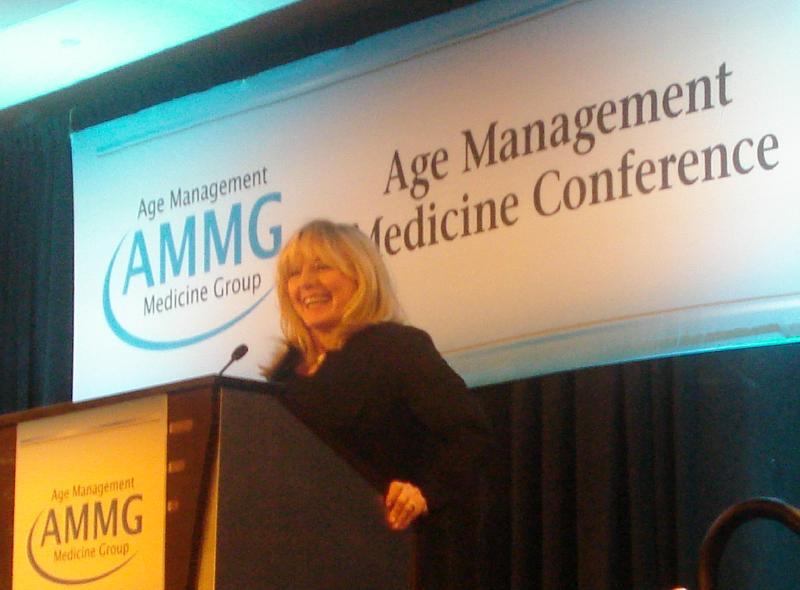
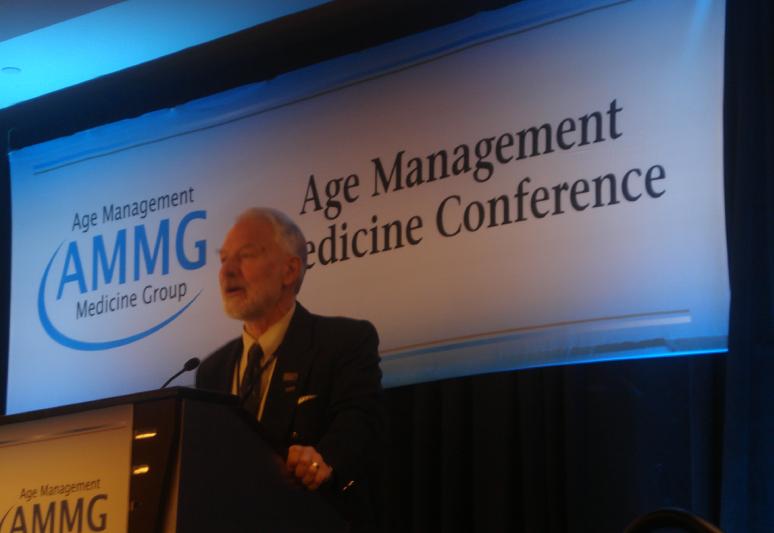
Friday,
November 1, 2013; [8;05 - 8:30] AM and [11:15 AM - Noon] PDT; Cosmopolitan Hotel in Las
Vegas, NV. Dr. Florence Comte, M.D. received the 2013 Alan P. Mintz Award for Clinical
Excellence in Age Management Medicine. Dr. Coles gave the keynote address on Clinical
Genomics for Age Management Medicine. There were 500 Registrants, 36 Faculty Members,
and 55 Exhibitors.
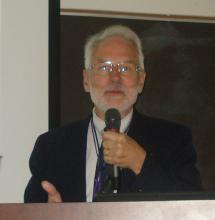
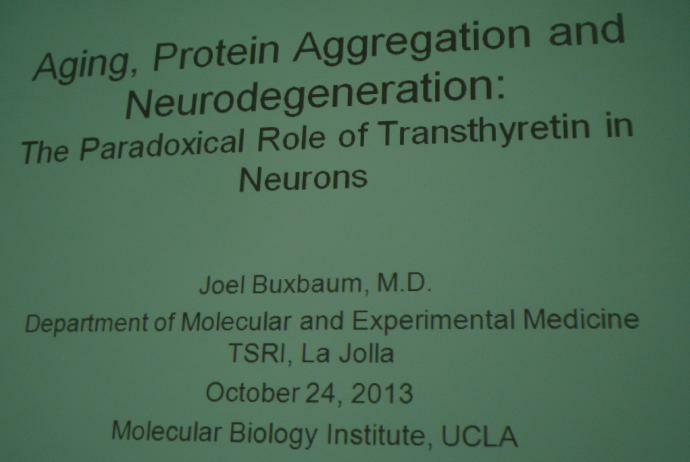

Thursday,
October 24, 2013; 4:00 PM; Prof. Joel Buxbaum, M.D. (R) of the Scripps Research Institute in
La Jolla, CA gave a lecture on the topic of "Aging, Protein Aggregation, and Neurodegeneraton:
On the Paradoxical Effect of TTR (Transthyretin) on Neurons and Alzheimer's Disease" to ~50
attendees at the UCLA Molecular Biology Institute. He was introduced by Dr. Stephen Coles (L)
who hosted him for the day.
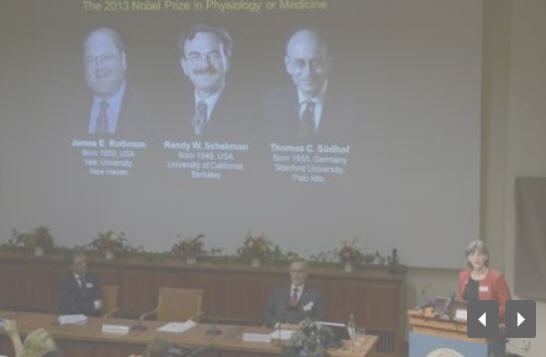
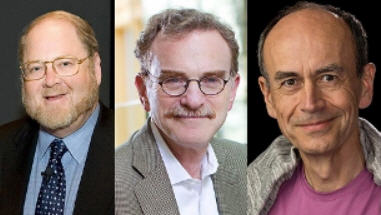
Work on 'cell traffic' and disease triggers wins Nobel prize; Juleen Zierath (R), Chairman of the Nobel Committee for Medicine or Physiology, speaks during the announcement of the winners of the 2013 Nobel Prize for Medicine or Physiology at the Nobel Assembly at the Karolinska Institute in Stockholm October 7, 2013. A portrait of U.S. scientist James Rothman and drafts of his work are displayed on a screen during a news conference at the Nobel Assembly at the Karolinska Institute in Stockholm.
Monday, October 7, 2013; Reuters - Janerik Henriksson - TT News Agency; Randy Schekman, a Professor at the University of California, Berkeley, smiles in this undated handout picture provided by the university on October 7, 2013. REUTERS-Peg Skorpinski University of California, Berkeley Handout via Reuters.
by
Niklas Pollard
Stockholm, SWEDEN (Reuters) - - Three U.S.-based scientists won the Nobel medicine prize on Monday for plotting how vital materials such as hormones and brain chemicals are transported within cells and secreted to act on the body, giving insight into diseases such as diabetes and Alzheimer's. Americans James Rothman, 62, Randy Schekman, 64, and German-born Thomas Südhof, 57, separately mapped out one of the body's critical networks that uses tiny bubbles known as vesicles to ferry chemicals such as insulin within cells.
The system, which also describes how vesicles transport molecules to the cell surface for secretion, is so critical and sensitive that errors and disruption in the mechanism can lead to serious illness or death.
"Without this wonderfully precise organization, the cell would lapse into chaos," the Nobel Assembly at Sweden's Karolinska Institute said in a statement when awarding the prize of 8 million crowns (US$1.2 million).
"Through their discoveries, Rothman, Schekman and Südhof have revealed the exquisitely precise control system for the transport and delivery of cellular cargo." For example, their research sheds light on how insulin, which controls blood sugar levels, is manufactured and released into the blood at the right place at the right time, the Nobel Committee said in the statement. Diabetes and some brain disorders have been attributed at least in part to defects in the vesicle transport systems.
Rothman is Professor at Yale University, Schekman is a Professor at the University of California at Berkeley, while Südhof is a Professor at Stanford University. The three, working separately, adopted quite different approaches to the problem, reflecting their own scientific specialties.
"My first reaction was, "Oh, my god!" said Schekman, who was woken with the good news in the early hours of his morning. "That was also my second reaction," he added, according to a Berkeley University statement.
Suedhof, a U.S. citizen, professed similar surprise. "It blew me over," he told Reuters. "Every scientist dreams of getting a Nobel prize. It's something I often tell my kids. If you lose your dreams you lose your reason to live."
Medicine is the first of the Nobel prizes awarded each year. Prizes for achievements in science, literature, and peace were first awarded in 1901 in accordance with the will of dynamite inventor and businessman Alfred Nobel.
Südhof said the work was really about "cell traffic," the ability of cells to move material around. "We have met each other many many times and argued and sometimes agreed and sometimes disagreed," he said of his fellow prize winners. "We really work in quite distinct areas of science."
Prof. Patrik Rorsman of Oxford University said the award was timely and well deserved. "It is such a fundamental process they have studied and explained. Their discoveries could perhaps have clinical implications in psychiatric diseases, but my guess is that they will be more useful for the understanding of how cells work."
The committee said the work could help in understanding immuno-deficiency, as well as brain disorders, such as autism.
Schekman, a geneticist, first became interested in how proteins move within cells in 1974. At the University of California, Berkeley, he began working on yeast, a single cell microorganism. Research showed his findings applied equally to human cells. Among Schekman's research aims is to study whether the accumulation of the protein amyloid in the brains of Alzheimer's Disease patients is due to disruption of the vesicle system.
Südhof, a Neuroscientist, has focused particularly on the brain and questions of human thought and perception, emotions and actions determined by signaling between neurons, cells which constitute the foundation of the nervous system. "I'm interested in understanding how is it possible for one cell to talk to another ... This field is one of the most fundamental fields involved in understanding how the brain works, which is one of the most important questions in biology today."
Jeremy M. Berg, Director of the Institute for Personalized Medicine at the University of Pittsburgh, said the research had tackled key questions of how molecules are directed by vesicles to the cell wall and secreted to act on the body. "You can't understand anything about how the brain works without understanding this process. You can't understand anything about hormone secretion without understanding this process.
"It's one of the prizes for which there is not a treatment that came out of it directly, but there are probably literally thousands of laboratories around the world whose work would not be taking place the way it is without their work."
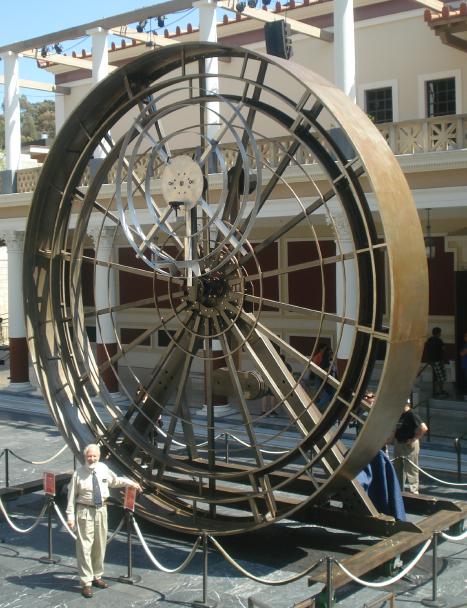

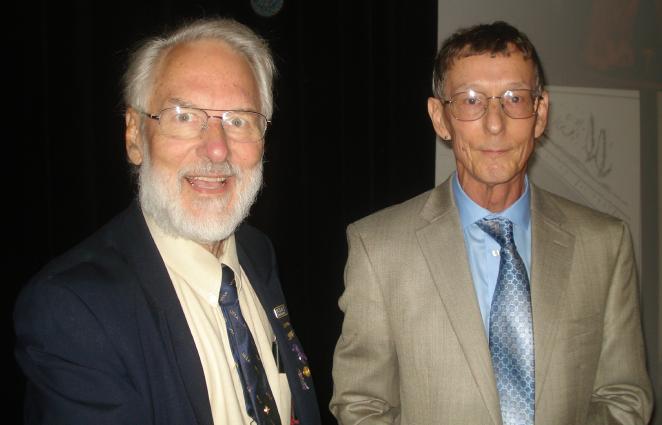
Saturday, September 21, 2013; 2:00 PM PDT; Prof. Mark Griffith of the Classics Department at
UC Berkeley received his Ph.D. in Greek and Latin Literature from Cambridge, UK and gave a
lecture to a full auditorium of ~100 persons on "Defying Zeus To Help Humans: What Was
Promtheus Thinking?" at the Getty Villa located in Malibu, CA.
According to the myth, when Prometheus (a Titan who used logic to anticipate the consequences
of his actions) stole fire from the gods on Mount Olympus and provided it to humans as a gift. In
retaliation, Zeus punished him eternally by impaling him through the rectum, channing him to
rock, and sending an eagle to eat his liver every day (while it grew back every night). This myth
is documented in the play by Aeschylus called " Prometheus Bound" (part of a trilogy), as
it was presumably performed in Athens, GREECE c. 425 BCE (a democracy even before
Socrates, Plato, Aristotle, and Alexander the Great). Prometheus tells the Chorus that he not
only gave humans fire but also taught men many of the civilizing arts, including writing,
medicine, mathematics, astronomy, metallurgy, architecture, and agriculture, so we have to guess
that he must have liked us. But Zeus is again angered when Heracles releases Prometheus from
his torment ~300 years later, and after an argument ensues in which Prometheus refuses to reveal
the name of one of Zeus's rivals, Zeus strikes him dead with a thunderbolt and plunges his body
into an abyss. (Sigh!)
And what about Epimetheus, a Titan brother of Prometheus (who was a rationalizer and who
only had excuses after the fact [his name means "after thought" while his brother's name means
"fore thought"])? As another punishment, Zeus ordered the creation of Pandora, the first
woman, as a means to deliver evil into the the domain of men. Despite the warnings of his
brother, Epimetheus happily received her as his bride, but as soon as she arrived she lifted the lid
of a jar entrusted to her by the gods, releasing a plague of harmful demons (spirits) upon
mankind. Our only hope, Elpis, remained behind to facilitate the continuation of our unfortunate
mortal race that otherwise would have been extinguished.
The Judeo/Christian/Islamic creation story in Genesis (Chapter 2) in which Adam and
Eve are punished by being expelled from the Garden of Eden, has similarities (like defying God
and then being punished), but discovering how to make clothing clearly doesn't have the same
technological significance as discovering how to make a fire - - not only to keep warm but to
cook meat. Why isn't the story of "fire" written into the Old Testament along with other
"just so" stories like "The Tower of Babel" to explain why there are different spoken languages
or "The Flood," in which God allegedly created a rainbow just as a message after a rain for us to
appreciate that He will keep His promises? Privately, Prof. Griffiths speculated that the Israelis
had political reasons for not including the creation myths of their adversaries in their version of
creation, lest their children credit their rivals with greater intelligence than their own parents
(Hebrew tribes vs. their rivals). Of course, the two different creation myths written down in
Genesis are never reconciled and both probably date back to an oral tradition that may have
been told as stories thousands of years before. One can imagine that there were arguments about
which version of creation ("Seven Days" vs. "The Garden of Eden") should be included in the
written (sacred) text, so they included both of them as a compromise without giving special
treatment (priority) to one or the other.
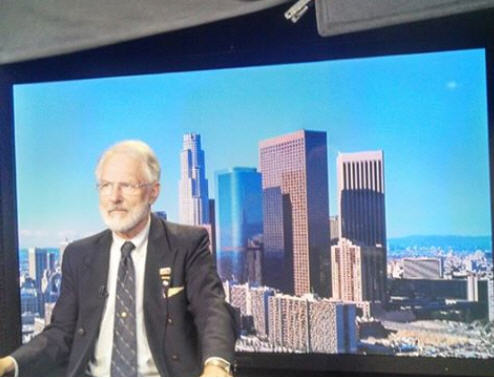
Wednesday, August 21, 2013; [9:49 - 9:55]
AM PDT; Click on the photo for the
CNN-TV Interview (TRT = 6 min. edited down to 2:30 min.) of Dr. Stephen Coles by
Mr. Rafael Romo, Senior Editor of CNN in Atlanta, GA on the exaggerated claim of
Mr. Carmelo Flores Laura from the high Andes Mountains of BOLIVIA, alleged by
family and Bolivian government officials to be the world's oldest person [living or dead] at age
123 yo, exceeding the Guinness Longevity record of French women Madam
Jeanne-Louise Calment, who died in 1997 at the validated age of 122 yo. No one has come
close to her extreme age in the last 16 years, and it is unlikely to happen that another
supercentenarian will exceed this record in our lifetimes. This is why we call the limit of 125 +/-
3 years the maximum human potential lifespan by the name The Calment Limit, a limit
that appears to be encoded in the human genome (3.1 GBP's [Giga Base Pairs] of DNA), since
extreme longevity is now known to be inherited, even though any of us could be struck by
lightning or hit by a truck while crossing the street, and this limit is regardless of one's normal
lifestyle (smoking, drinking alcohol, gender, race, geographical location, occupation, religion,
diet, exercise program, etc.), despite the fact that the human population is increasing
exponentially [the base of the pyramid] and that average life expectancy in all developed
countries has systematically increased in a linear fashion for many decades (filling out the
volume of the apex of the pyramid, and thereby increasing the number of healthy centenarian
individuals in the pool who could potentially exceed the Calment Limit).
US life expectancy in the year 1900 was only 49 yo, while today in the year 2013, it's 78 yo - - a
more than 50 percent increase. We know the reasons why the Top-Ten Diagnoses for Causes of
Death (on Autopsy) in the US have shifted for the last century from childhood infections (due to
the discovery of vaccines), bacterial epidemics (due to the discovery antibiotics coupled with
hygienic public-health measures for separating chlorinated/fluorinated drinking water from
sewage), and obstetrical complications (due to the availability of C-Sections based on surgical
sterile-technique under general anesthesia as well as an understanding of the "ABO"
RBC-antigen system for type-and-cross-matched blood transfusions, which didn't come into its
own until after WW-I) to be replaced with chronic conditions, like heart disease, cancer, stroke,
COPD, diabetes, and Alzheimer's Disease, for which there are few "silver bullets." Interventions
in the aging process itself are the most likely means to provide further advances in actuarial,
population-mortality statistics, rather than trying to cure one disease at a time, now that all the
"low-hanging fruit" has been exploited. However, there is no current agreement among
biogerontologists about how to do this. They're all like the proverbial blind men touching the
elephant each with his or her own understanding of how to solve the problem and, of course,
each asking for funding to follow their personal agenda.
In the mean time, we must remain skeptical about claims of extreme longevity that magically
appear in illiterate populations without proper documentation, despite the wishful thinking of
home boosters for their local areas with access to newspapers and TV stations that have access to
the Internet that now are able to get our attention. See the WWW.GRG.ORG
Supercentenarian Section on the left index, for Incomplete or Fraudulent Claims for
more details about Longevity Myths that fall in the same category as "The Lock Ness
Monster," where demographers were not present to contradict claims of extreme old age in
hard-to-travel-to locations with seductive, romantic-sounding names like Shangri La.
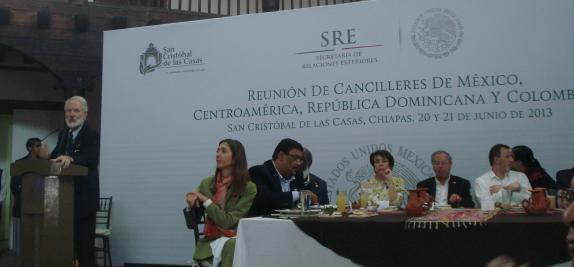

Friday, June 21, 2013 [1:45 - 2:10] PM CDT; Dr. Stephen Coles gave a lunch-time talk on
supercentenarians and the demographics of aging to ~50 Delegates and Ministers of Mexico,
Central America, the Dominican Republic, and Colombia at their one-day conference in San
Cristobal de las Casas, the historic capital of the Mexican State of Chiapas (in the highlands
South of Mexico City and not too far from Guatemala).

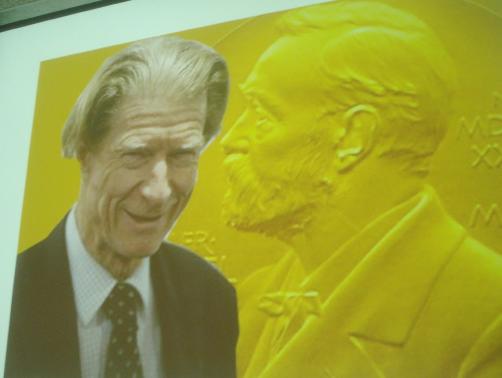
Friday, May 17, 2013; 4:00 PM; Sir John Gurdon, 79, of Cambridge, University; UK, Nobel Prize in Physiology or Medicine in 2012 for work in embryology that he did while at Oxford University, lectured to a Special UCLA Embryology Club on "Nuclear Reprogramming in Oocytes" hosted by Prof. Eddy De Robertis.
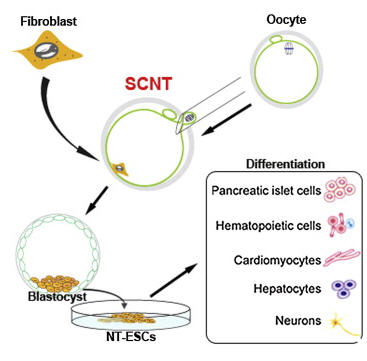

May 16, 2013; Portland, OR (Oregon Health Sciences University) - - As published in the
journal Cell [1], Dr. Shoukhrat Mitalipov, Ph.D. and his team of 23 scientists at OHSU
have taken us one-step closer to the therapeutic cloning of human stem cells [2, 4, 5] using the
same technique that Dr. Ian Wilmut used to bring us Dolly, the Sheep in 1996; it's called
Somatic Cell Nuclear Transfer (SCNT). BTW, the human cloning work was funded by
a French Foundation and not by NIH, which did fund Mitalipov's earlier cloning work with
monkeys. This is only worthy of mention in the context of the bioethical and legal controversy
regarding the presumed destruction of human embryos and the position of the Roman Catholic
Church/HolySee/Vatican/Pope(s) on this matter [3].
Prof. Irving Weissman, M.D. of Stanford University said "The new results are extremely
important." Dr. Robert Lanza, M.D., CSO of Advanced Cell Technology (ACT), called the work
"... a major scientific achievement." Due to the uncertainty regarding iPSC technology and the
potential for tumor-formation/immune-rejection, "SCNT may be the only way to truly reprogram
cells [for autologous therapeutic purposes]." Dr. José Cibelli, Ph.D. of Michigan State
University said, "It will only be a matter of time before this work will be tested therapeutically in
monkeys." Dr. Michael D. West, Ph.D., said that "One of the tricks described in the paper is to
use caffeine [to slow the tendency of human egg cells in culture to begin mitotic
divisions prematurely that apparently doomed prior efforts with human cells], the Starbucks
Effect!"
There were a significant number of complaints by subsequent critics about the figures
(redundancy) and the figure-captions that went with the paper but nothing that would invalidate
the work or require a retraction. The take-home lesson for all of us is that landmark papers like
this one should not be rushed into print or posted on-line before they are fully vetted by
reviewers, since many readers will be rigorously scrutinizing the paper, even if they were not
direct competitors located at other labs.
Refs.:
1. Masahito Tachibana, Paula Amato, Michelle Sparman, Nuria Marti Gutierrez, Rebecca
Tippner-Hedges, Hong Ma, Eunju Kang, Alimujiang Fulati, Hyo-Sang Lee, Hathaitip
Sritanaudomchai, Keith Masterson, Janine Larson, Deborah Eaton, Karen Sadler-Fredd, David
Battaglia, David Lee, Diana Wu, Jeffrey Jensen, Phillip Patton, Sumita Gokhale, Richard L.
Stouffer, Don Wolf, and Shoukhrat Mitalipov, "Human Embryonic Stem Cells Derived by
Somatic Cell Nuclear Transfer," Cell, Vol. 153, No. 6, pp. 1228-38 (May 15, 2013)
Click for the paper at
cell.com.
Click for a video at YouTube
. From the video, it looks easy, and one doesn't get a feeling for how difficult manual
dexterity, technical skill, and extensive experience must be in carrying out the task of puncturing
the oocyte membrane and driving a nucleus (from a skin-cell punch biopsy [with emulsified cells
separated] into the enucleated oocyte cytoplasm and then using a "secret sauce" of chemical
cytokines for nutrition and one or more jolts of a small DC electric current to trigger the onset of
mitotic divisions (without over-differentiation) to form a cell-line in an incubator with the proper
CO2/O2 atmosphere, body temperature, and darkness without being
disturbed for a specified period of time {and playing the correct classical music in the
background :-) }. One must use a two hands independently on sensitive position controllers, and
a suction air hose with one's mouth while examining the specific cell of interest through a
high-power microscope on a highly stable platform with shock absorbers.
Highlights:
a. Cytoplasm of human oocytes reprograms transplanted somatic cell nuclei to pluripotency;
b. NT-ESC's can be efficiently derived from high-quality human oocytes;
c. Human
NT-ESCs are similar to ESCs derived from fertilized embryos.
2. Melissa Healy,
"Stem Cells Are Made by Cloning Method," The Los Angeles Times, pp. A1, 13 (page 1
above the crease) (May 16,2013).
3. Op-Ed, "The Specter of Human Cloning," The Los Angeles Times, p. A17 (May 17,
2013). The last sentence implored, "Adding a clear prohibition [with a law in California to make
reproductive cloning illegal] would help to assure the public that stem-cell research should be
embraced, not feared"
4. Gautam Naik, "Experiment Brings Human Cloning One Step Closer," The Wall Street
Journal, pp. A1,2 (May 17, 2013).
5. Andrew Pollack, "Cloning Is Used to Create Embryonic Stem Cells," The New York
Times, p. A17 (May 16, 2013).
"Researchers fused skin cells with donated human eggs to create human embryos that were
genetically identical to the person who provided the skin cells."
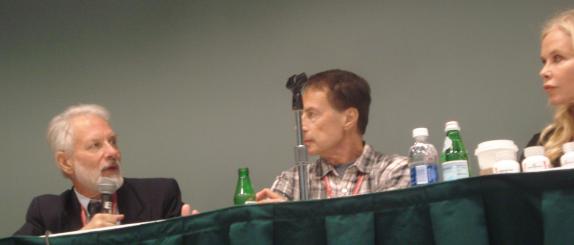

Sunday, March 3, 2013 [2:00 - 3:30] PM PST; An expert panel for a public audience of ~100
focused on human longevity and was held at the Health Freedom Expo located at the
Long Beach Convention Center. The panel was entitled "Longevity: How to Make 100 the New
50 (Stem Cells, Cytokines, and Telomeres)." This panel, led by pioneers in their field, provided
an exciting tour of the most recent discoveries in the key fields that impact how we age and
explored the very real possibility that we can STOP AGING as we now know it. The Panel was
moderated by Ms. Greta Blackburn and included, Drs. Aubrey de Grey, L. Stephen Coles, Bryant
Villeponteau, and Gregory Fahy, along with Daniel Holtz and David Kekich.


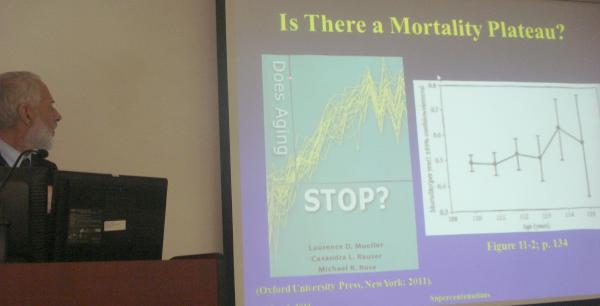

Thursday, January 31, 2013; 12:00 PM; L. Stephen Coles presented "Not My Last Lecture"
(originally "Supercentenarians: Secrets of the Oldest Old") Noontime Multidisciplinary Research
Colloquium on Aging at USC Davis School of Gerontology and the Andrus Gerontology Center
in downtown Los Angeles. Prof. Caleb E. (Tuck) Finch, Ph.D. sat in the first row.
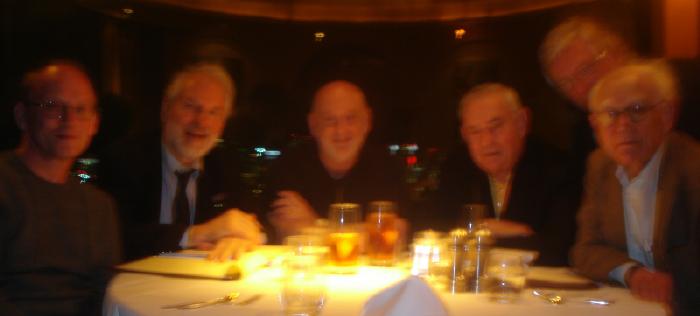
Saturday, November 17, 2012; 7:30 PM PDT; Profs. L. Stephen Coles, S. Jay Olshansky,
Leonard Hayflick, Bruce Carnes, David Staats, M.D. (Geriatrician), and Jacob Seagle
(Demographer and Author of a standard text on actuarial sciences) met for dinner to discuss
future funding of basic research in gerontology in connection with the 65th Annual GSA meeting
in San Diego, CA.
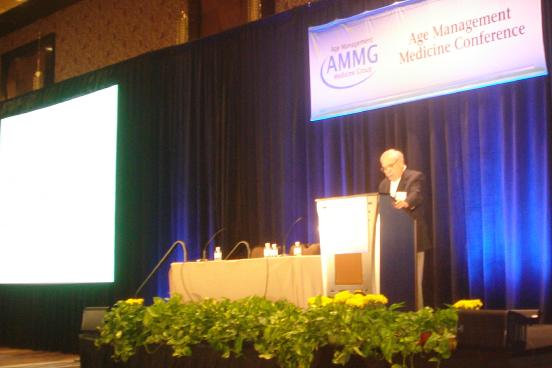
Friday, November 2, 2012; 8:30 AM PDT; Prof. Leonard Hayflick, my instructor in Medical
Microbiology at Stanford University in 1974 (38 years ago), is acknowledged to be one of the top
ten gerontologists in the world today for his discovery of what we now call "The Hayflick Limit"
(the limit on the number of replications of fibroblasts as a function of minimum telomere length
was shown to be 50 +/-10). I invited him to present as our Keynote Speaker at a four-day
AMMG Conference in Las Vegas, NV at the Cosmopolitan Hotel. - - Stephen Coles
The belief that aging is still an unsolved problem in biology is no longer true. To understand this belief, it is necessary to define the four phenomena that characterize the finitude of life : (1) aging; (2) the determinants of longevity; (3) age-associated diseases; and finally (4) death. Age changes can occur in only two fundamental ways: Either (1) as the result of a purposeful program driven by our genes or (2) by stochastic (random) accidental molecular events.
The weight of evidence indicates that a gene-driven program does not govern the aging process; it is the stochastic or random loss of molecular fidelity that does. Potential longevity is determined by the energetics of molecules present after reproductive maturation, including those that compose the repair machinery involved in turnover, synthesis, and maintenance. The repair and synthesis processes that exceed the appearance of dysfunctional molecules prior to reproductive maturity then shifts so the spread of energy described in The Second Law of Thermodynamics [entropy] that creates an excess of dysfunctional molecules, begins to exceed repair capacity and the thermodynamic instability characteristic of the aging process begins. The maintenance, repair, and synthetic pathways that maintain the fidelity of molecules produced before and after reproductive maturity determine longevity. Unlike the stochastically-driven aging process, longevity determination is governed by the human genome. Furthermore, the aging process is fundamentally distinct from age-associated diseases.
Unlike diseases, age changes occur (a) in every multi-cellular animal that reaches a fixed size in adulthood; (b) and cross virtually all species barriers; (c) in all members of a species only after the age of reproductive maturation; (d) in all animals removed from the wild and protected by humans even when that species probably has not experienced "aging" for thousands or even millions of years; (e) in virtually all animate and inanimate matter; and (f) with the same universal molecular etiology -- that is, thermodynamic instability. Unlike aging, there is no disease or pathology that shares all six properties. Because this critical distinction is rarely understood, the enormous imbalance of resources spent more on studying age-associated disease than conducting research on the fundamental biology of aging cannot be expected to increase our knowledge of the aging process.
He also mentioned privately that "Studying the longevity of lab mice is like studying creatures from Mars! Studying highly inbred lab mice as opposed to wild-type mice doesn't tell us very much about the fundamental basis for natural aging."
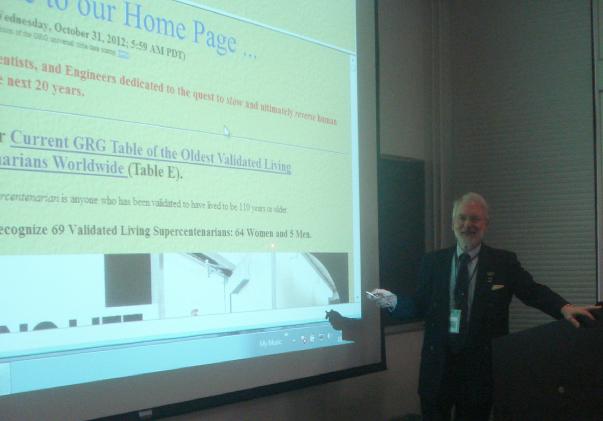
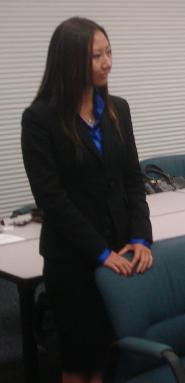


October 31, 2012; Associate Prof. Fu Wei of Bejing and Rong Li, Deputy Director General of the
National Population and Family Planning Commission of the People's Republic of China hosted
a delegation of 30 persons visiting UCLA as part of a tour of the USA. Dr. Coles presented the
latest statistics on extreme world wide longevity. Ms. Ivy Xiao of UCLA served as a translator
for the group.
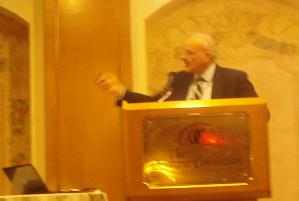
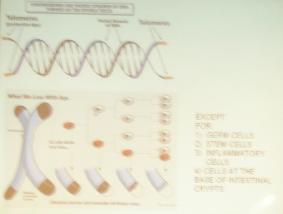
Saturday, October 27, 2012; [10:00 AM - 4:30 PM] - - The UCLA Longevity Center (Prof. Gary
Small, M.D., Director) presented a one-day seminar at The Olympic Collection in West Los
Angeles. Keynote speaker Prof. David Heber, M.D., Ph.D., FACP, FACN and Director of the
Center for Human Nutrition spoke on "Nutritious Eating and an Active Lifestyle for Healthy
Aging." The second slide demonstrates the concept of telomere erosion and the Hayflick
Limit.

Profs. L.
Stephen Coles (UCLA) and Howard Friedman (UC Riverside) then hosted a session on "The
Centenarians - - Life Past the Century Mark: A Look at the Art and Science of Living Past 100
and the Characteristics of Centenarians."

Thursday, October 25, 2012; Prof. Douglas C. Wallace, Ph.D. of the Center for Mitochondrial
and Epigenomic Medicine of the Children's Hospital of Philadelphia Research Institute in
Pennsylvania presented a 4:00 PM Molecular Biology Institute Seminar on the topic of "A
Mitochondrial Etiology of Complex Diseases: Verification Through Mouse Models."
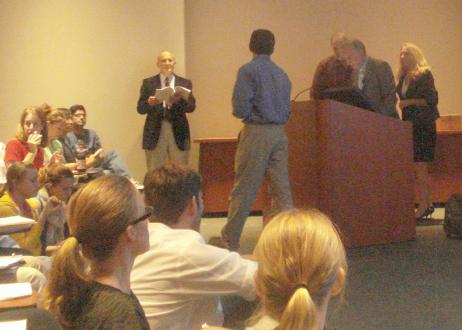
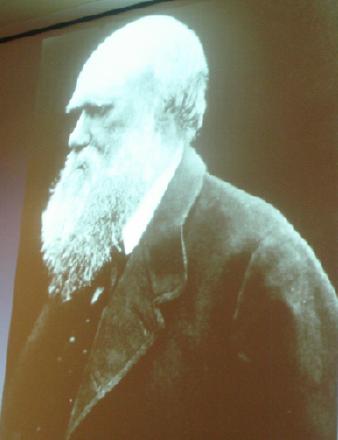
Tuesday, October 9, 2012; Prof. Richard Dawkins of Oxford presented a Noon IMED Seminar at
the UCLA David Geffen School of Medicine to a packed NRB Auditorium on the topic of
"Darwin's Five Bridges." This was one of Dawkin's best lectures ever and the challenging Q&A
afterward by a few adversaries was handled in a masterful fashion. Click on his photo to watch
his lecture on the Internet.
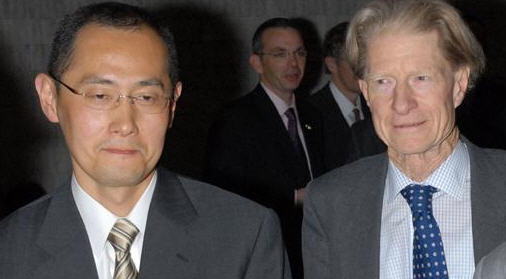
Monday, October 8, 2012; Profs. John B. Gurdon of the UK and Shinya Yamanaka of JAPAN
shared this year's Nobel Prize in Physiology or Medicine for their work in so-called Cellular
Reprogramming, which has unleashed a wave of advances in everything from cloning to the
possible treatment of diseases using stem cells.
Refs.:
1. Gautam Naik, "Stem-Cell Scientists Win Nobel Prize," The Wall Street Journal, pp.
A1,2 (October 8, 2012).
2. Eryn Brown and Jon Bardin, "Nobel Prize Honors Two Stem-Cell Research Stars: An Old
Hand from Britain (79) and a Younger Japanese Scientist (50) Profoundly Altered Beliefs about
Biology," The Los Angeles Times, pp. A1,8 (October 9, 2012).
3. Nicholas Wade,
"Cloning and Stem Cell Work Earns Nobel," The New York Times, pp. A1,9 (October
9, 2012).
4. "Gurdon Gets an 'F' in Science in Grade School with Instructions Not To Waste His Time,"
CNN Anderson Cooper 360 (October 9, 2012; 5:58 PM PDT; TRT=2 min.)
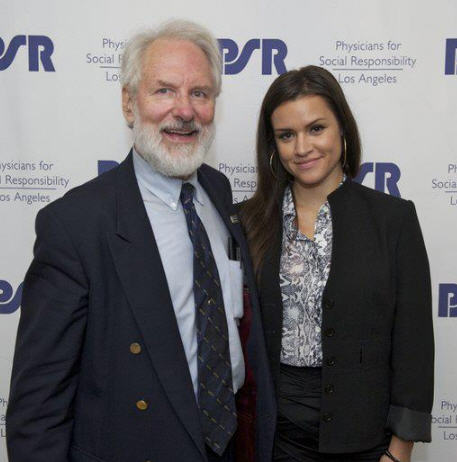
Sunday,
September 9, 2012; [6:30 - 10:30] PM; PSR-LA Board Member L. Stephen Coles M.D., Ph.D.
and Natalie Coles at thye September Gala at the Beverly Wilshire Four Seasons Hotel.
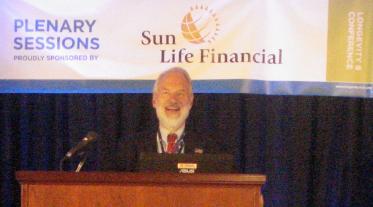

Friday, September 7, 2012; 8:30 AM EDT; Dr. Coles was invited to present the keynote address
"Secrets of the Oldest Old" to the Longevity 8, the Eighth International Longevity Risk
and Capital Markets Solutions Conference in Waterloo, Ontario, CANADA, to 160 attendees
from 16 counties. The Conference and sponsored by the world-wide insurance and pensions
industry. Click on the second photo of the Panel Discussion for more details.

Saturday, September 1, 2012; [1:00 - 5:30] PM; Sheraton Universal Hotel in Hollywood, FL Dr.
Coles does a book signing at the 40th Annual Cancer Convention.

August 21, 2012;
Bao Bao, the oldest known male panda died in Berlin at the age of 34 yo. Click on his photo for
more details.
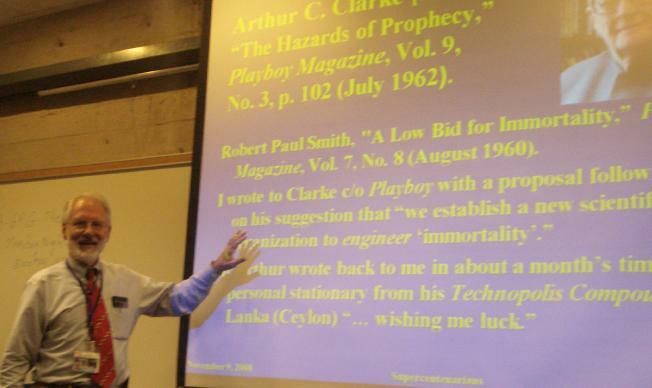
Friday,
August 10, 2012; 10:00 AM PDT; Classroom 320; 1010 Wilshire Blvd. in Westwood, CA; Dr.
Coles completes a 20-hour course on "Successful Aging for the Individual and for Society" with
the Osher Lifelong Learning Institute (OLLI) of the UCLA Extension Program for 22 adult
students.

Wednesday, August 8, 2012; 7:30 PM; Prof. Doron Melamed, Ph.D., an immunologist at the
Technion in Haifa, ISRAEL [the Israeli equivalent of MIT and CalTech combined with the
exception that there is a medical school across the street {Rambam Hospital}] who lectured in
Beverly Hills at the home of Joan and Arnold Seidel for the American Technion Society, spoke
on "Turning Back the Clock: An Approach to Reversing the Aging Process." Melamed's Lab has
proven the hypothesis that the increasing immune incompetence with age and the decline in
B-Cell Lymphocyte numbers (the cells that synthesize antibodies) is not due to the capability to
synthesize new B-Cells in the bone marrow compartment (in the peripheral blood, these cells last
only about two weeks before being replenished), but due to the increase in the numbers of
"Memory Cells" (which last for decades and are the cells that are created after immunizations, for
example, to give one permanent immunity to certain disease-causing microbes). Memory Cells
provide transcription factors that serve as a negative feedback loop on the production of fresh
B-Cells. If the large numbers of Memory Cells that increases with exposure to more and more
antigens over a lifetime could be cleared out then maybe the machinery to create more B-cells
could be turned back on. This is exactly what happened in a group of tens of mice that
Melamed's Lab tested using a drug called Rituxan. Unfortunately, a full life-history experiment
was not performed to verify that the experimental mice lived statistically-significantly longer
than controls due to cost considerations. Rituxan is a chemotherapy drug (that is administered by
IV in a hospital or clinic once a week for a period of [4 - 6] weeks frequently in combination with
methotrexate) that is indicated to treat Non-Hodgkin's Lymphoma. Melamed is working with
hematology oncologists to test the immune function of patients with lympoma who are taking
Rituxan already to identify the Transcription and Complement Factors that control the synthesis
of fresh B Cells. This work serves as a proof of concept for future research.
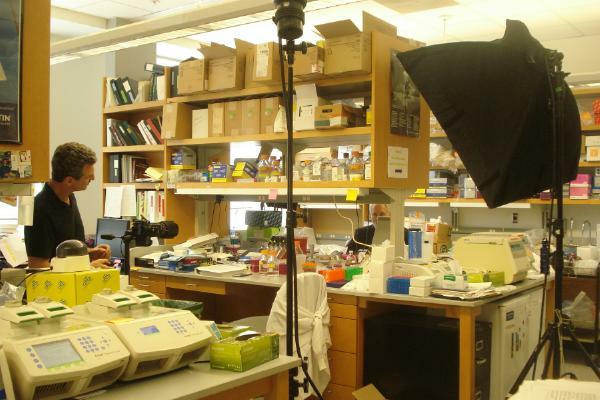
Monday, August 6, 2012; 1:30 PM; Professional Photographer, Mr. Gregg Segal of Altadena, CA
under contract to Wired Magazine, shot 218 digital camera portrait photos in three
hours at the UCLA Lab of Drs. Eric Vilane, M.D., Ph.D. and Ruth Baxter, Ph.D. of Stephen
Coles for a story on aging research. The story is expected to appear in the October issue of
Wired.
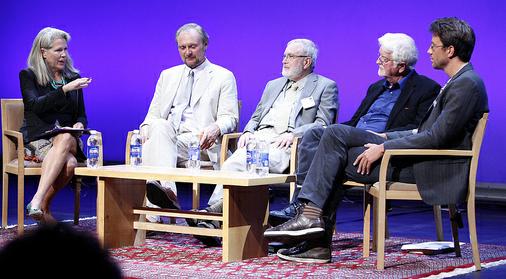

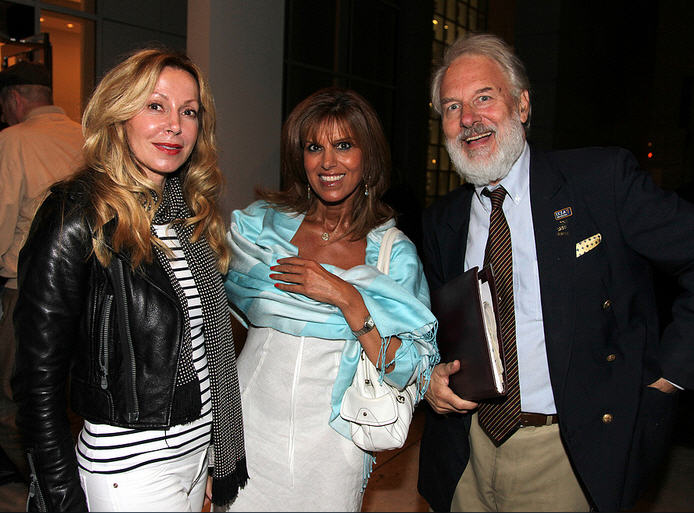
Monday, July 26, 2012; [7:30 - 9:30] PM; Los Angeles, CA; The Getty Center Museum and
Zocalo Public Square presented a Distinguished Panel discussing the topic "What Does Heaven
Look Like?" to an audience of over 200 visitors in the Harld M. Williams Auditorium.
The Takeaway: Heaven's Nice, But Hell's More Fun To Paint!
Human depiction
of the afterlife is as varied as our diverse cultures.
Where's heaven? What's it like? Who gets in? And what tortures await those of us who land in
the alternative destination?
It was revealed that there are at least two heavens: (1) a "Celestial" Heaven which lies
somewhere high up in the sky (over the rainbow); and (2) a "Terrestrial" Heaven that corresponds
to the "Garden of Eden," as described in Genesis, assuming that you can find it (BTW,
the East Gate of the Garden is guarded by an Archangel with a "flashing and flaming sword" (so,
a heavy-duty angel, not a Cupid with tiny wings) to ensure that no mortal human(s) reenter after
we were expelled for our "original sin" (eating from the "Tree of Knowledge" when we explicitly
prohibited from doing so) as we were tempted by the serpent and lest we eat from the second tree
- - the "Tree of Life" - - and become like us {immortal?} [the only occasion in the Bible, to
my knowledge, that God speaks of Himself as a "plural" entity {leading us to conclude that
Heaven may be populated by a pantheistic "tribe of gods" who preexisted the creation of Adam
and Eve. If you're looking for a plot for a new Bible story, here it is! Wait - - Wasn't this written
down by Egyptians, Greeks, and Romans, as something that we now call mythology, but which
for them was the real thing?}]).
Since your spirit (soul), which presumably leaves the mortal body at the time of
your death, and your body which decays almost immediately with the onset of death
(which must be rendered as youthful and "perfect") are to be reunited (integrated) in Heaven
(assuming you're deemed worthy and admitted by Saint Peter to pass through the "pearly gates")
in order for you to "be with God," this would present a paradox of sorts, depending on how you
died. For example, if you were eaten by a pack of wolves as the "cause of your demise" then the
wolves would have to regurgitate your body parts before assimilating them into their wolf bodies
so that these parts could be properly reassembled and magically transformed into a youthful
form. Could you fine tune this scenario further, as you ostensibly meet with all of your long lost
relatives who predeceased you back to the time of Adam and Eve, whom you haven't seen in a
while but can now fill in on what you and they have been doing since you last saw each other on
Earth, even if you weren't born before they died so you never intersected in time? BTW, is there
a divine news service to track the activities of our heavenly hosts and the hierarchy of angels who
live there in harmonious bliss, so that we can be brought quickly up-to-date upon our arrival into
the next life?
Also, where will the 40 virgins be found to fulfill the promise made to male Islamic suicide
bombers when they martyred themselves with an explosion to kill the non-believers with a
guaranteed ticket to "Paradise." What if there are not enough virgins in Heaven to go around?
Maybe their Islamic Heaven is in a different place and the virgins in question were never real
women on the Earth.
This leads to another paradox of sorts... If the conditions for admission require that you have
been baptized as a Catholic and have had a ritual of Last Rights administered by a priest before
you die, what about the innocent babies who were born but died of a disease before they could be
baptized. At one time it was assumed that they resided in "limbo," anther location between
Heaven and Hell that awaited Jesus to determine their disposition at the end of time (whenever
that would be). Jesus has dominion over a great many things (as explained in Revelation
, the last book of the New Testament).
"Purgatory" is another concept that requires some fine tuning. The panel's conclusion was that
the concept of Heaven (and Hell) is a fuzzy, slippery slope that can lead you down any direction
you chose.
Here are some more details...
Scholars of religion, history, and art asked these questions during a panel discussion at the Getty
Museum, in which they explored the ways different societies have imagined and depicted the
afterlife and what the images we create of Heaven and Hell say about life on Earth.
Producer and documentary filmmaker Jody Hassett Sanchez opened the conversation by asking
UCLA Buddhism expert Robert Buswell where, according to the Buddha, the heavens are
located.
"There are many different heavens in the Buddhist system," said Buswell as many as 27. But they
don't have a geography: the heavens are a level of rebirth, like existence as a human being or an
animal. In fact, going to heaven is "kind of a consolation prize" for Buddhists. The real goal is to
experience nirvana, which can't be located, measured, desired, or experienced.
In medieval Christianity, heaven is above, while hell is below. There's an opposition between
going up and going down, said Martin Schwarz, the curator of the Getty exhibition "Heaven,
Hell, and Dying Well: Images of Death in the Middle Ages." And while hell is usually depicted
with a lot of detail in medieval art, heaven is shown with much less specificity it's not in one
particular place.
On the other hand, for Native American tribes of the West, heaven was something very
literal, said UCLA anthropologist Peter Nabokov. In Pueblo Indian society, there is no idea of
sin, so everyone gets into heaven. A picture of heaven he found contains a certain number of
trees, a pile of dead rabbits for an imminent feast as well as corn being harvested. In heaven, your
ancestors are also waiting for you.
Quoting Belinda Carlisle "Heaven Is a Place on Earth" Hassett Sanchez asked UC Santa Barbara
religion historian Jeffrey Burton Russell about whether Heaven and Earth ever come together in
the Judeo-Christian tradition.
"Heaven is where God is," said Burton Russell. The location is beyond space and time, however.
Up until the 1600's or 1700's, Christians believed quite literally that you traveled up to Heaven
via a ladder or stairs, or circles as in Dante's Divine Comedy. And even though Dante
described Hell specifically, he used metaphor to describe Heaven. Heaven, said Dante, was
beyond language.
Even medieval artists, in depicting heaven, did it in a way that showed that it lies outside human
perception viewing it through a window or even choosing to hide it behind a wall, explained
Schwarz.
In Buddhism, said Buswell, there is a physical body in some heavens, but in higher levels of
heavens there is no physical embodiment. You can't even try to paint these heavens.
Nabokov brought the conversation back to earth. "I'd like to introduce a little history and reality
into all this conceptual talk," he said. "For colonized people around the world, the 19th century
was the end of the world." For Native Americans in California and indigenous people around the
world, the 19th century was a hell on earth, and their visions of heaven were those of release
from mass murder and disease. In California, Indians came together in earth lodges and prayed
for the world outside to be cleared of white people and hogs (who ate the acorns), for the land to
be re-carpeted with wildflowers, and for those who had been killed by disease to return. These
"very concrete, very practical cosmologies of what heaven on earth would look like" were
developing all over the world at this time, according to Nabokov.
So how does one get into Heaven, anyway?
While today we desire a quick and painless death, for a medieval Christian, said Schwarz, a
quick death was the worst thing, because you couldn't prepare for the afterlife.
In the Christian tradition, said Burton Russell, if you're a sinner and you repent even at the
moment of death it's enough to get you into heaven.
In Buddhism, the process of death involves "very elaborate visualization exercises," said
Buswell. These can take up to 40 days, as a person is guided through rebirth.
Before turning to the audience for the question-and-answer session, Hassett Sanchez asked the
panelists whether our fixation today on living well rather than dying well is a luxury. Do other
cultures, past and present, think of the afterlife differently because their life on earth is so
difficult?
Nabokov said that the primary concern of Native Americans in life and death is the community
rather than the individual. In Pueblo Indian society, the health of the community is much more
important. When the community is thriving, people live in the present; when the community is
suffering, they imagine alternative heavens in response.
Said Burton Russell, "It is indicative of our modern society that we tend to think of ourselves as
individuals divorced from the rest of people." Today, we see death as being far into the future we
try to have fun on earth to avoid it. But living a good life, in western religion, is not about having
fun it's not the point.
In the question-and-answer session, the audience asked the panelists to talk more about the
intersection between religion and history. How did the plagues of the Middle Ages affect people's
conceptions of Heaven and Hell?
After the Black Death in the 14th century, said Burton Russell, you saw more terrifying and
immediate representations of death. The image of the skeleton, said Schwarz, is often related to
the plague.
Have horrifying images of Hell been used throughout history to keep people under control?
In the middle ages, said Schwarz, people paid a lot of money to commission books full of
beautiful but terrifying paintings of Hell. In Buddhism, said Buswell, there are very elaborate
depictions of suffering in Hell to encourage (incentivize) good behavior.
Overall, though, Heaven and Hell have a disappointing record when it comes to discouraging
vice. Or, to put it another way, Heaven and Hell have been more successful in inspiring good art
than in inspiring good behavior.


Monday, July 23, 2012; 12:30 PM PDT;
Children's Hospital; Los Angeles, CA. The Ion Bus is a mobile DNA sequencing platform
designed to travel around the country to visit healthy elderly and sequence their genes right on
the spot in less than 6 hours. The bus started in Florida and went to NYC before coming to Los
Angeles.
US$10 Million will be given to the first team to successfully sequence the whole genome of 100 healthy centenarian subjects within 30 days at a maximum cost of $1,000 per genome at an error rate no greater than 1 per million base pairs and achieves best-in-class requirements for the following prize categories: Accuracy, Completeness, and Haplotype Phasing.
Conceived by Dr. J. Craig Venter, the goal of the competition is to usher in a new era of personalized medicine, revolutionizing genomic sequencing and challenging scientists to design rapid, inexpensive, and accurate whole genome sequencing technologies.
Drs. Coles, Finch, and Kedes are shown during an interview for the press about the project. Click on the bus to learn more of the details.

Sunday, May 27, 2012; 10:00 PM; Natalie S. Coles chats with Dr. Young Ghe Chung, a world
expert Veterinarian in animal cloning at the Gladstone Restaurant in Pacific Palisades, CA.

Sunday, May
27, 2012; 2:30 PM; Dr. Stephen Coles attends an International Fulbright Scholars BBQ during
the Memorial Day Weekend.
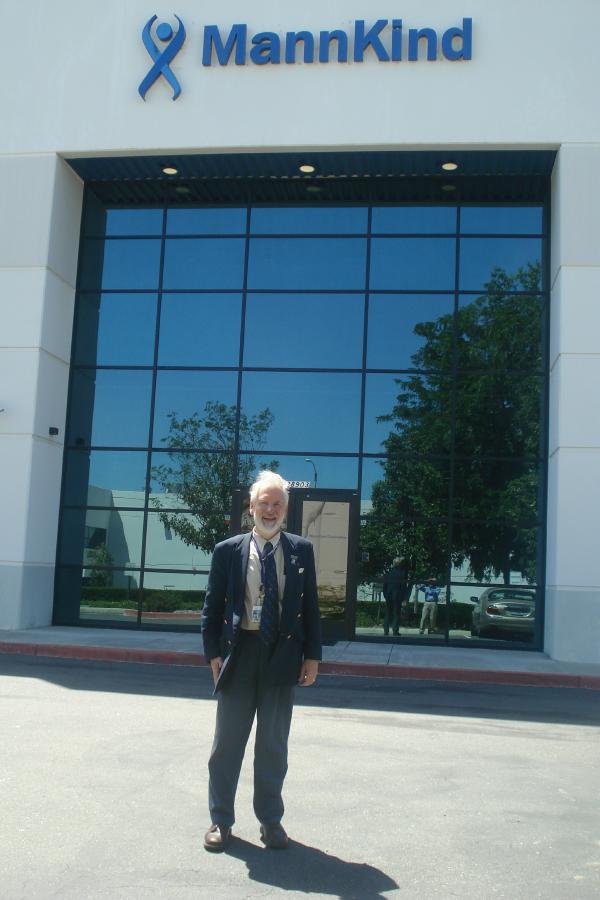
Wednesday,
May 23, 2012; 3:30 PM; Dr. Stephen Coles inspects the labs at the Alfred E. Mann Mannkind
Facilities.
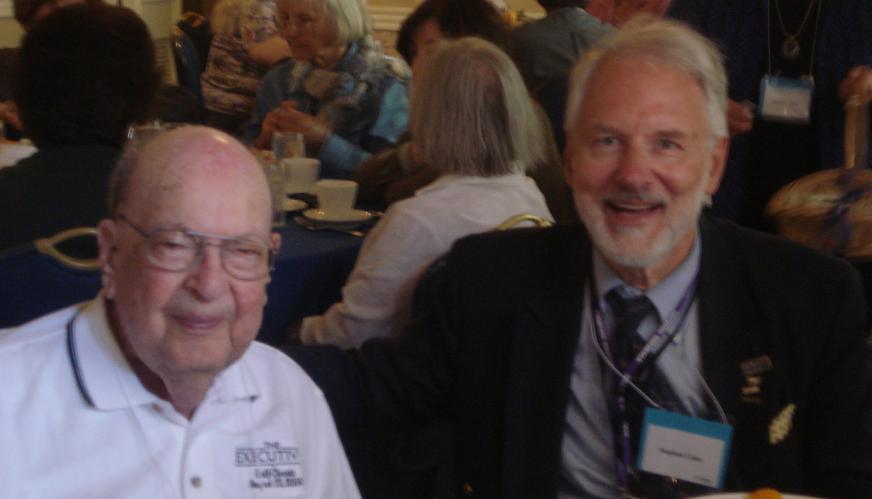
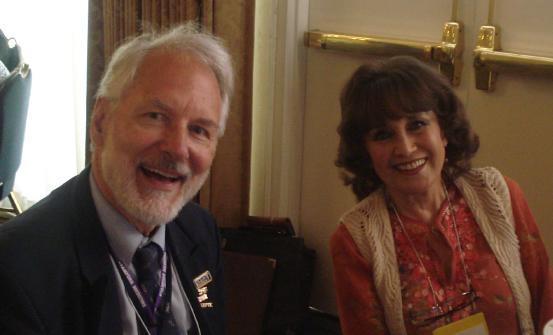
Thursday, May 17, 2012; 12:45 PM; Dr. L. Stephen Coles gave the Keynote Lecture to the
UCLA Affiliates luncheon on "The Secrets of the Oldest Old" to about 50 interested members.
Sherman in the photo above is 102 years old himself.
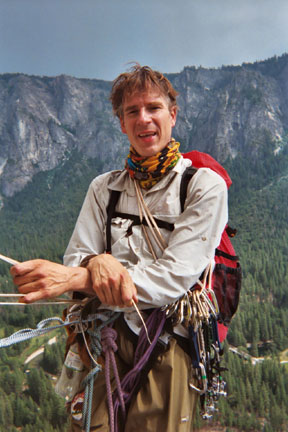
Sunday, May 13,
2012; 2:00 PM; CalTech; Pasadena, CA; Christof Koch, Lois and Victor Troendle Professor of
Cognitive and Behavioral Biology in the Biology Division, spoke to the Skeptics Society
regarding the topic of his new book, Consciousness: Confessions of a Romantic
Reductionist (MIT Press; Cambridge, MA; 2012). Click on his photo for more details.
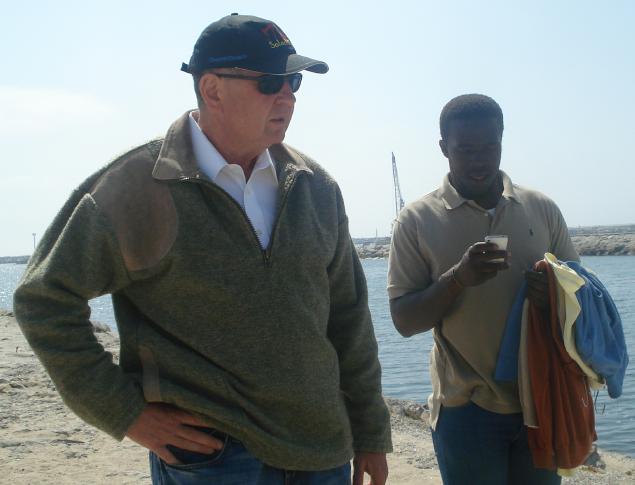
Wednesday, May 9, 2012; 4:30 PM PDT; Playa del Rey, CA; For a 30-second unlisted
YouTube Video Commercial made for David Steinman for Congress for the California Primary
Election that will take place on June 5th, click on the photo above. You may have to type in the
link manually as http://youtu.be/Mh7BuO1f_sI Dr. Coles appears briefly giving an
endorsement along with Ms. Alexandra Paul, one of the actresses from Baywatch (a
popular TV Series from the [1989 - 2001] time period).
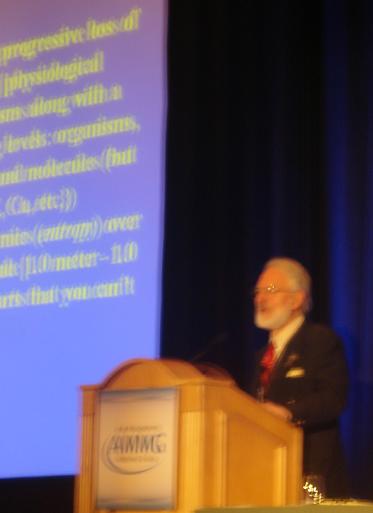
Sunday, May 6, 2012; 1:00 PM EDT; AMMG Conference Lecture at the Westin Diplomat Resort
and Spa; Hollywood, FL; Dr. Coles presented the autopsy data on the "Neuropathology of a
Supercentenarian with Severe Senile Dementia."

Wednesday, April 18, 2012; [8:00 -- 9:10] AM PDT; Department of Medicine, Stanford
University; Stanford, CA; Dr. Anthony Fauci, M.D. of NIH gave a superb one-hour review of
HIV/AIDS research at Grand Rounds: "Are We Close to a Cure?" Although a vaccine has not
yet arrived after 30 years of substantial effort, the value of male circumcision for risk reduction
was made conspicuously clear.
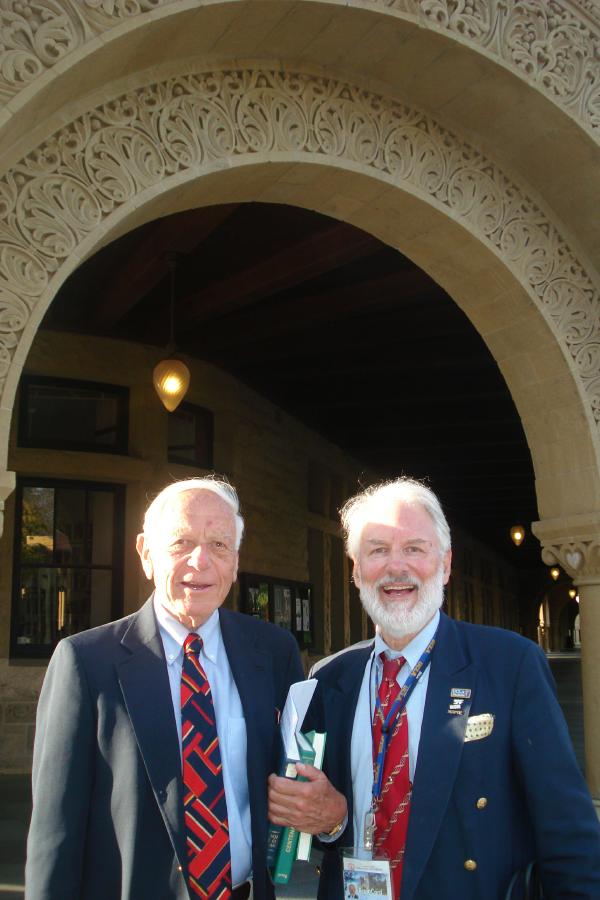
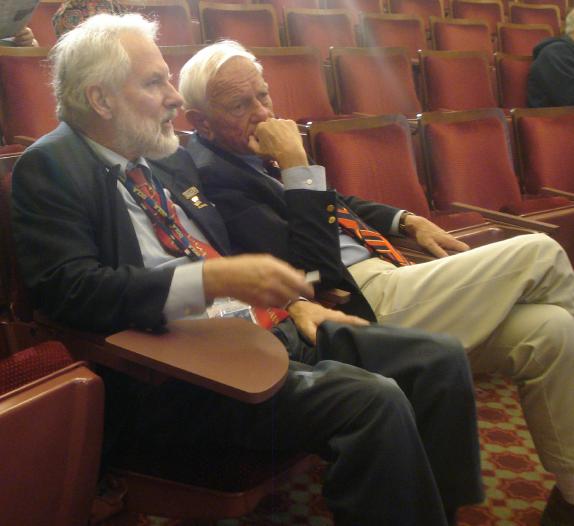
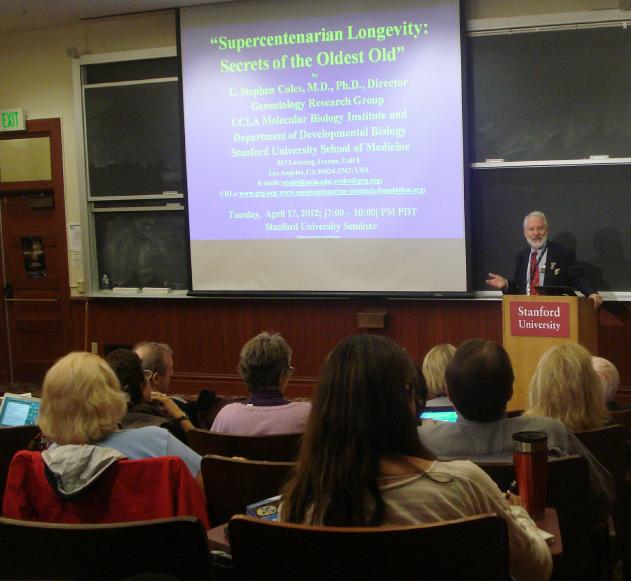
Tuesday, April 17, 2012; [7:00 - 9:00] PM PDT; "The Roadmap to 100: The Science of Living a
Long Life," a Ten-Week Course at Stanford University's Continuing Education (Bio-05) by
Walter M. Bortz, II, M.D.; Stephen and Natalie Coles presented a lecture entitled "Inside the
Lives of the World's Oldest People" containing over 100 PowerPoint slides to over 75
students.
We had an early diner with Stanford Immunologist, Prof. James Fries, M.D. with whom I've worked for over 38 years (as well as his wife Sarah) before the start of our Lecture.

Saturday, March 31, 2012; 3:00 PM PDT; Tustin, CA; Steve Coles and Vint Cerf of Google in
Washington, D.C.
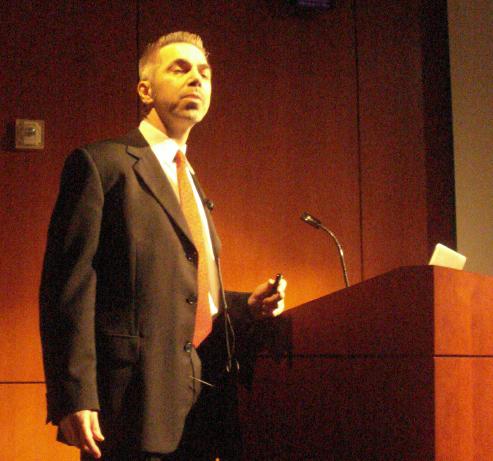
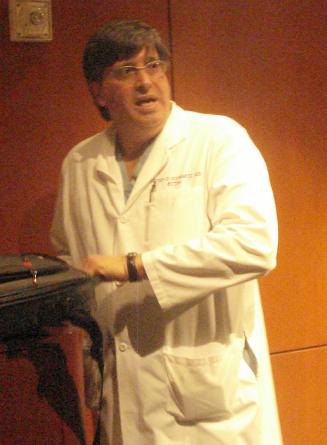
February 29, 2012; Noon; Drs. Robert Lanza of ACT and Steven Schwartz of UCLA
Ophthalmology jointly presented the first FDA-approved clinical trial on diseases of the eye
using human embryonic stem cells at the IMED Seminar. Click on the first photo for more
details from The Wall Street Journal.
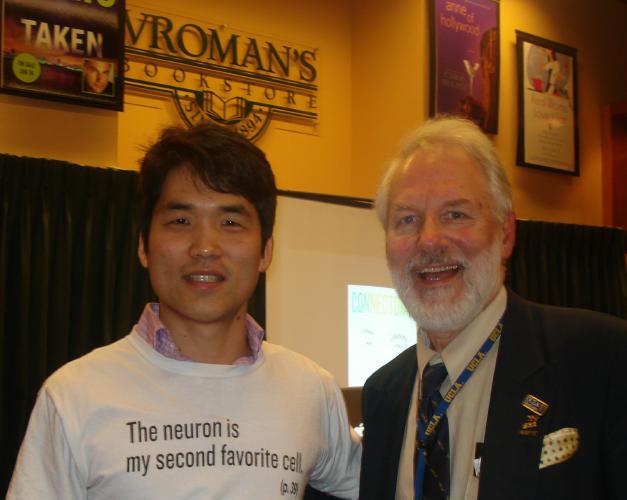
February 15,
2012; On a national book tour for his new book The Connectome, Prof. Sebastian Seung
made a one-hour presentation at Vroman's Books in Pasadena, CA.
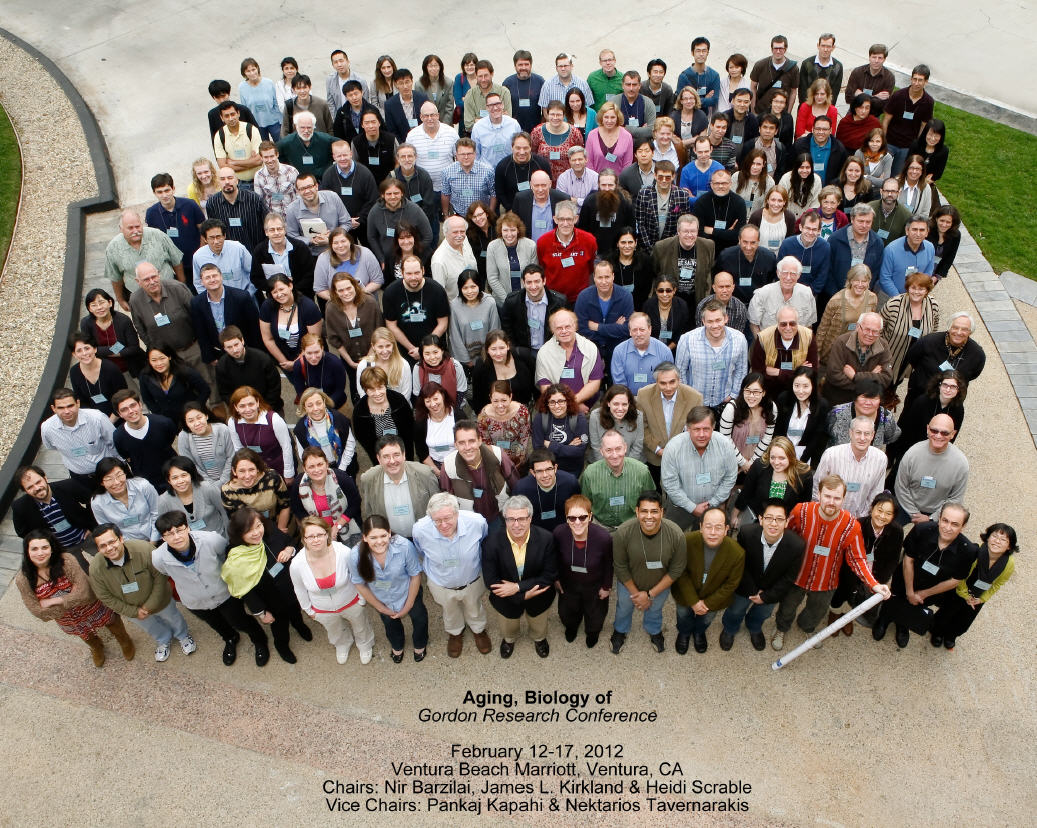
February 14, 2012; The Gordon Research Conference on the Biology of Aging was held in
Ventura, CA from February 12-17, 2012. Attendees included George Martin, M.D., Seattle,
WA; Aubrey de Grey, Ph.D., Cambridge, UK; Hinco Gierman, Ph.D., Stanford University; Tom
Perls, M.D., Boston University; Cynthia Kenyon, Ph.D., UCSF; Richard Miller, M.D., Ph.D.,
University of Michigan; Steven Austad, Ph.D., University of Texas; Elliot Bergman, Ph.D.,
Valdosta, GA; Nir Barzilai, M.D., Einstein, New York City; Jan Vijig, Ph.D., Einstein; New
York City; Judy Campisi, Ph.D., Buck Institute; Novato, CA; Brad Wilcox, M.D., Honolulu, HI;
Tom Kirkwood, Ph.D., UK; Nicholas Schork, Ph.D., UCSD; Gordon Lithgow, Ph.D., Buck
Institute, Novato, CA; Rita Effros, Ph.D., UCLA; Stephen Coles, M.D., Ph.D., UCLA; and
Valter Longo, Ph.D., USC.
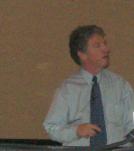
Tom Perls, M.D. Boston University
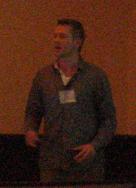
Hinco Gierman, Ph.D., Stanford University
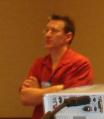
Brad Wilcox, M.D.; Honolulu, HI
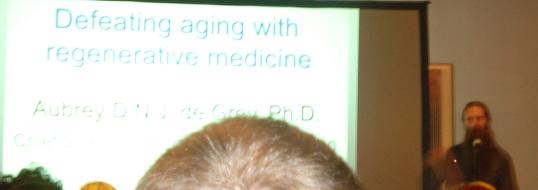

February 12, 2012;
7:00 PM; Dr. Aubrey de Grey, Chief Science Office of SENS, gave a one- hour lecture to 60
attendees of the Local SENS Chapter Meeting at the Brewery in downtown Los Angeles near the
USC Keck School of Medicine.
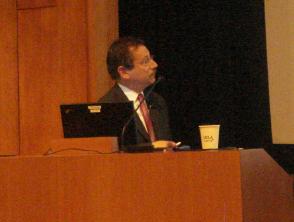
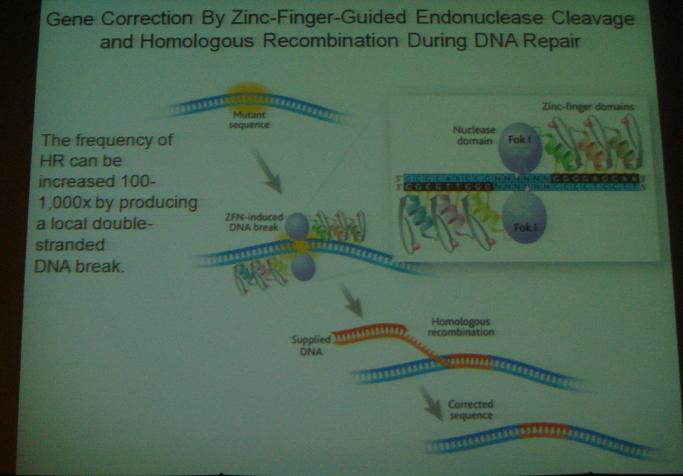
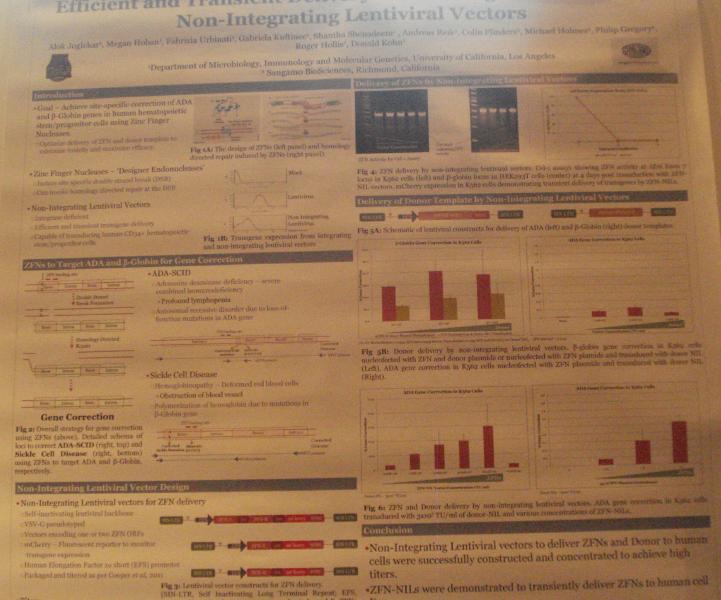
Friday, February 10, 2012; [8:00 AM - 4:30 PM]. Dr. Jonathan Thomas, Ph.D., J.D., the current
Chairman of CIRM, started the Eight Annual UCLA Stem Cells Symposium: Stem Cells and
Cancer with a discussion of the prospects for a new round of funding from the State of
California when current funding is expected to be completed in about five years. Recall that
under Robert Klein, Prop. 71 [2004] provided $3 billion over a ten-year period of which $1.3B
has been spent with $[5-6] million committed in RFA's for next year. CIRM has provided
universities with a significant amount of infrastructure and buildings for its private and public
universities as well as training grants for students, Residents, and Post-Doctoral Fellows.
Collaboration with researchers around the world has been a hallmark of CIRM's approach.
Collaboration with California-based industry has also been important to translate basic resaerch
into commercial products. But in order for the citizens of California to provide a similar amount
of support in the future, CIRM will have to demonstrate value for this investment in the form of
cures for specific diseases that will impact health-care economics within our state. One such
disease is Sickle Cell Disease (SSD), which affects more than 80,000 persons. The Mendelian
genetic basis for SS Anemia has been known for decades (a point mutation in in the Beta
Hemoglobin gene {G=C --> A=T} results in a {Glu -- > Val} amino acid substitution in the final
protein [the mutation is maintained in the general population, since it confers a modest resistance
to malaria] resulting in the formation of rouleaux [a stacking of hemoglobin tetramers
like a roll of coins due to self-stickiness] ultimataly deforming membranes of Red Blood Cells
giving them a sickle shape under the microscope and blocking them from passing easily
(deformably) through narrow capillaries, thereby chocking off blood flow to the distal
(downstream) veins resulting in significant pain in the joints [due to tissue anoxia] for those
afflicted with this condition. Little can be done today short of a bone-marrow transplant from a
sibling donor to alleviate this disease, which disproportionally afflicts Black Americans. In my
opinion, curing the root-cause of SSD through CIRM funding, could be the "Silver Bullet" that
would be needed to convince the public to renew a next round of funding. The cure is on the
drawing boards in the form of genetic engineering in which Zinc Fingers (six nucelotides on each
side of the corrected sequence) would be used to do a snip-out and back-in a genetic correction to
the bad gene in the native chromosome in which the defective gene resides. The zinc-finger
technology is being developed by a company in Northern California (Sangamo
Biosciences of Richmond, CA) and has been tested using a viral vector in animal models.
(See the poster above that will be published soon.) A Phase-1, FDA-approved human clinical
trial is planned to begin in about two years with autologous bone-marrow transplants (obviating
the concern about using anti-rejection drugs), hopefully in time to influence public opinion when
it is most needed. The beauty of this approach is that the technology is generic, since it could be
applied to a wide variety of genetic diseases and not just SSD.
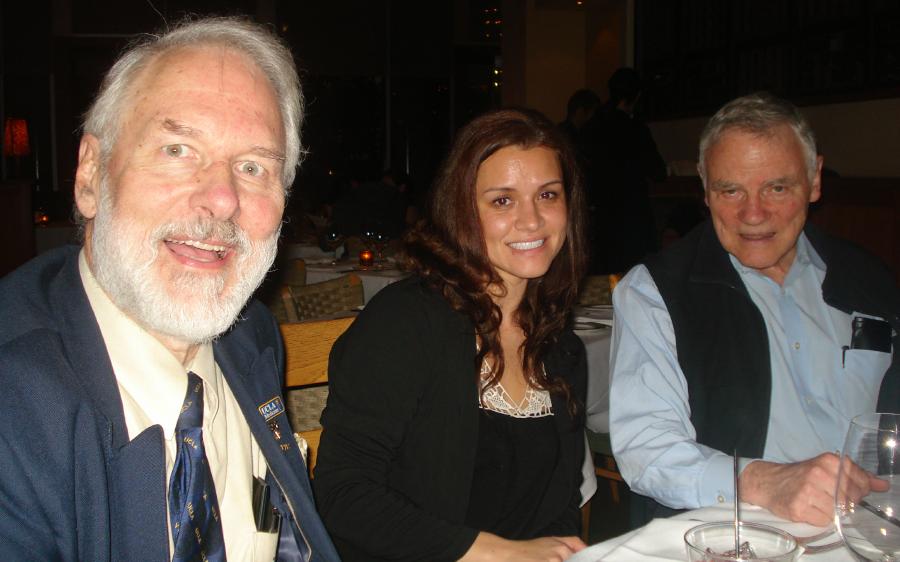
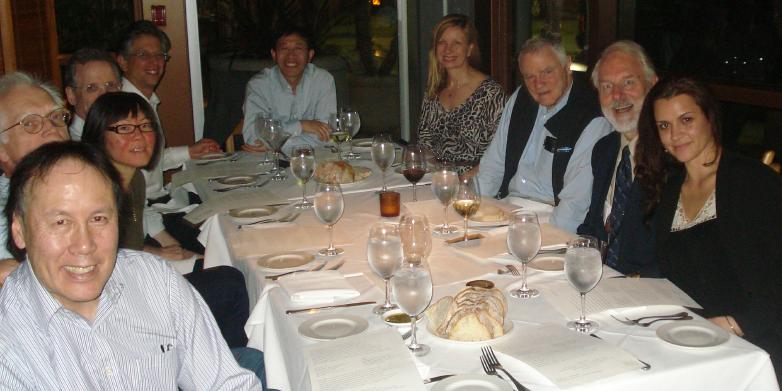
Wednesday, February 8, 2012; 12:00 Noon. Prof. Leroy Hood, M.D., Ph.D., Director of the
Systems Biology Institute of Seattle, WA gave a talk to the UCLA IMED Seminar to a full
audience on the topic of "Systems Biology, Transforming Technologies, and the Emergence of
Proactive 'P4' Medicine." BTW, P4 stands for "Predictive, Preventive, Personalized,
and Participatory." Genomic biology is digital; however, proteomics is still
analog, so it's slower going. The cost of complete sequencing will go from ~$4,000 today to
under $1,000 at the end of next year. Furthermore, the cost is forecast to go down to $200 in five
years. So, after that time, all newborns will have their sequences routinely done at birth; the
sequence will be anonymized and placed in a public data base for biostatistical analysis. Indeed,
doctors may come to request a genomic/epigenetic profile to be done every year on all patients
over age 60 on an annual basis, as part of their routine screening. Click on the first photo above
for a direct link to the P4 Medical Institute and a short peek
into the future of medicine as it will be practiced in five years.


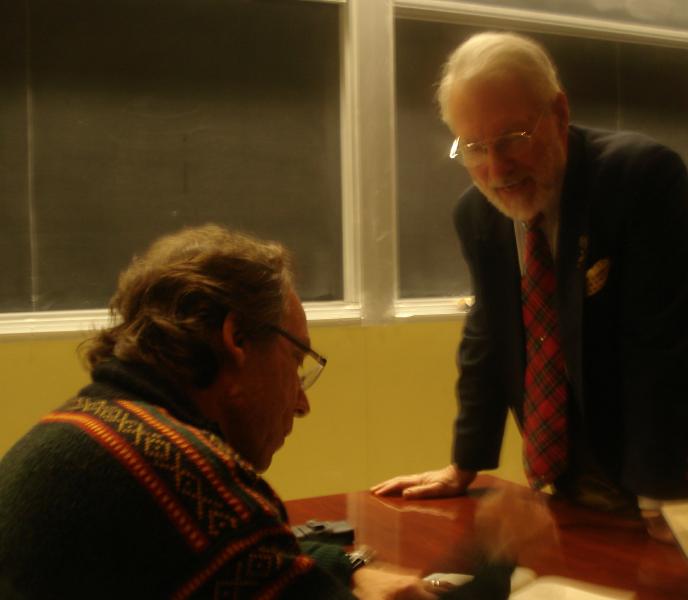

Where did the universe come from? What was there before? Why was there something rather than nothing? Such questions have been at the heart of religious and philosophical debates about the existence of God, but in recent years science has been closing in on the answers. Krauss takes us back to the beginning of the beginning, presenting the most recent evidence for how our universe evolved and how it's going to end - - not with a bang but with a whimper. As Richard Dawkins writes "This could potentially be the most important scientific book with implications for supernaturalism since Darwin."
In the Audience was a famous magician, The Amazing James Randi, 84, a long-time member of two different skeptics societies. Click on his photo above for a link to his Foundation and the unclaimed US$1,000,000 prize for the first person to demonstrate a supernatural capability that withstands the scrutiny of scientific skeptics.
Click for News Items from 2011.